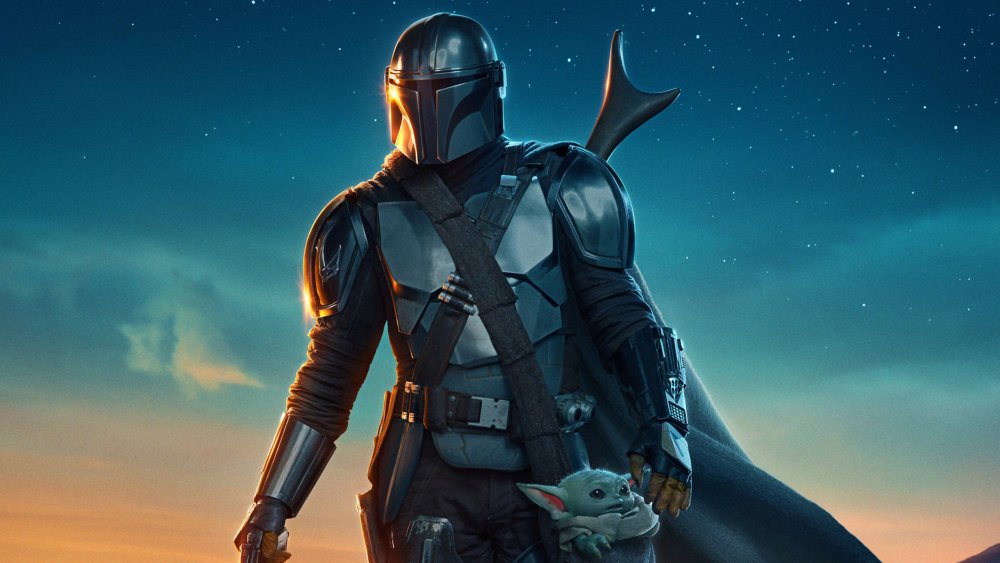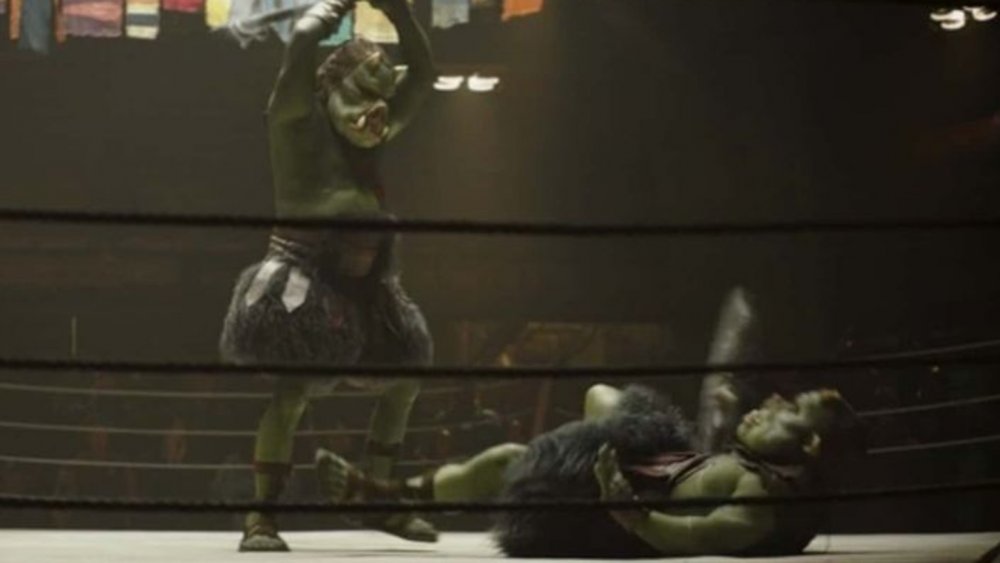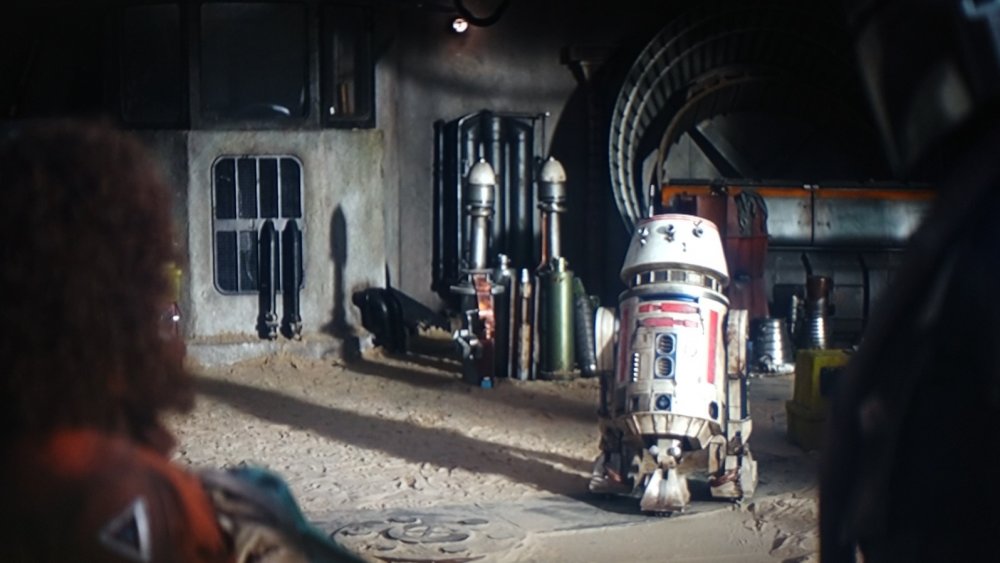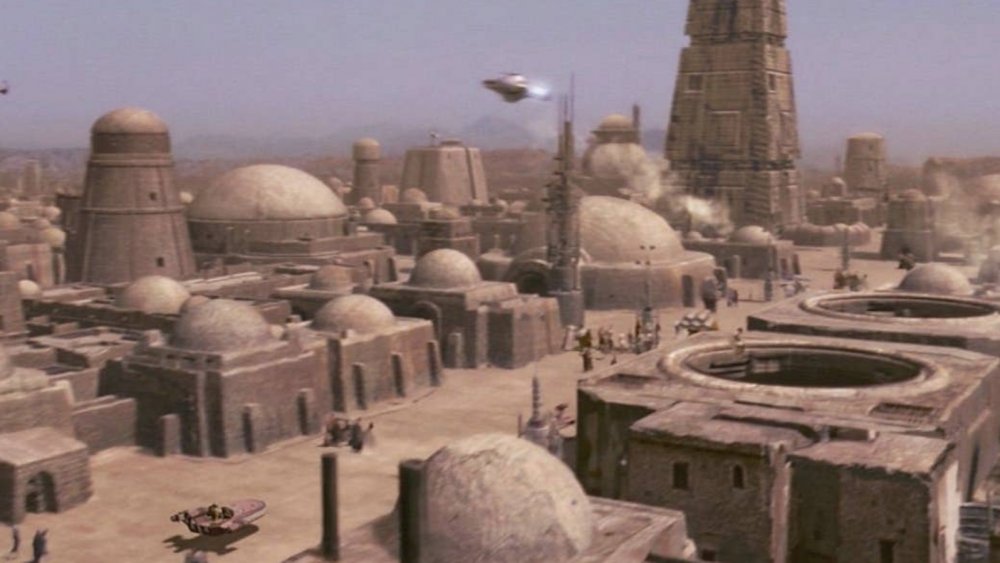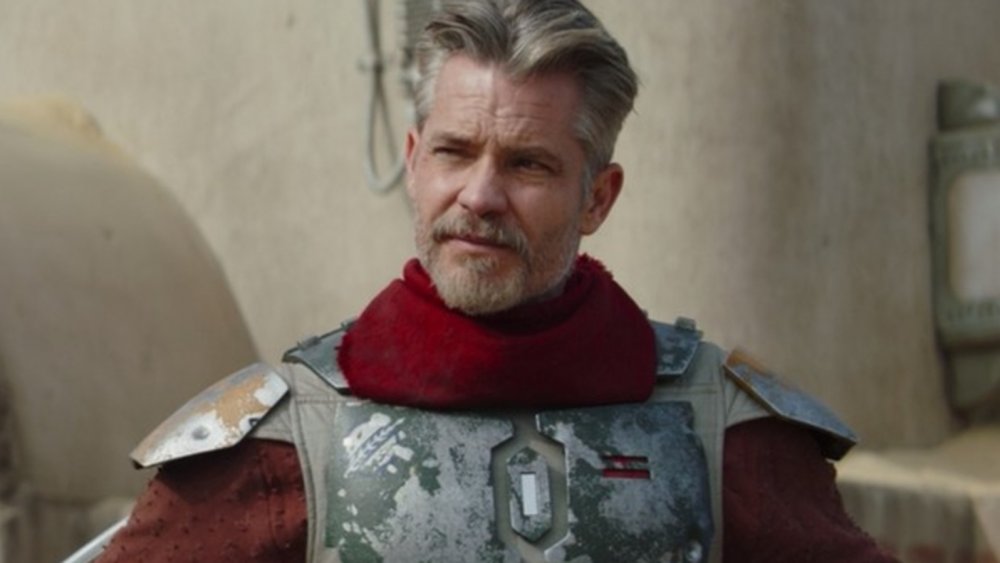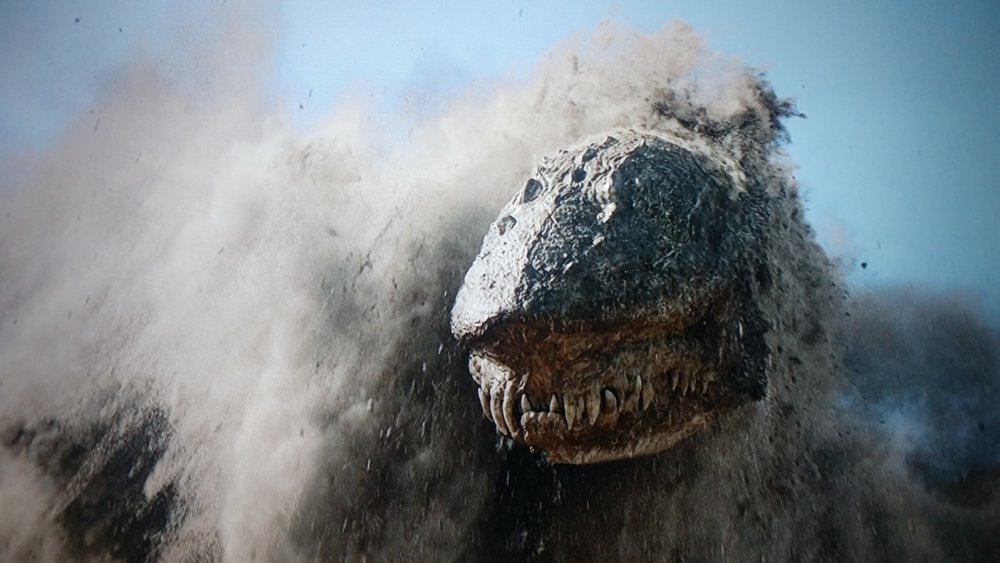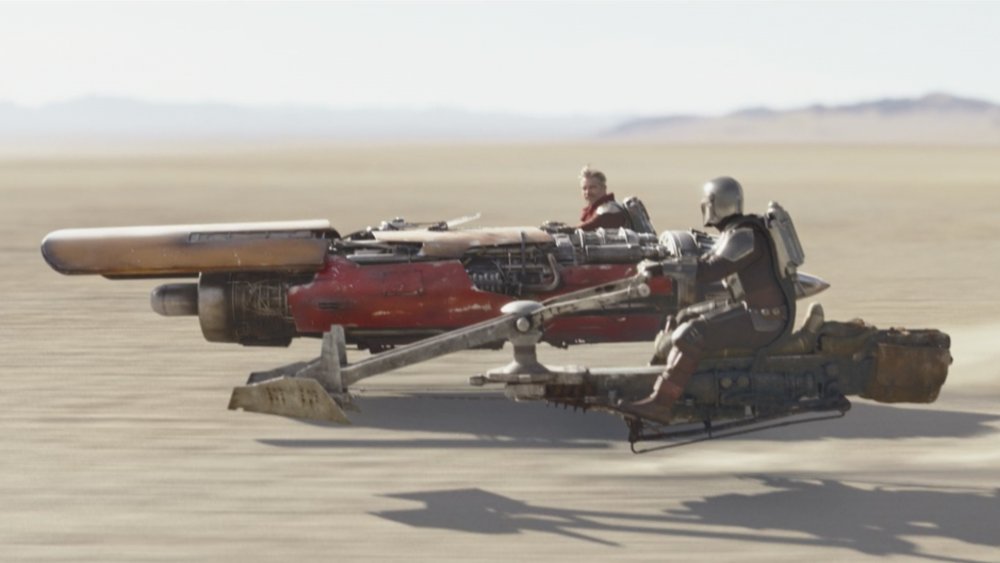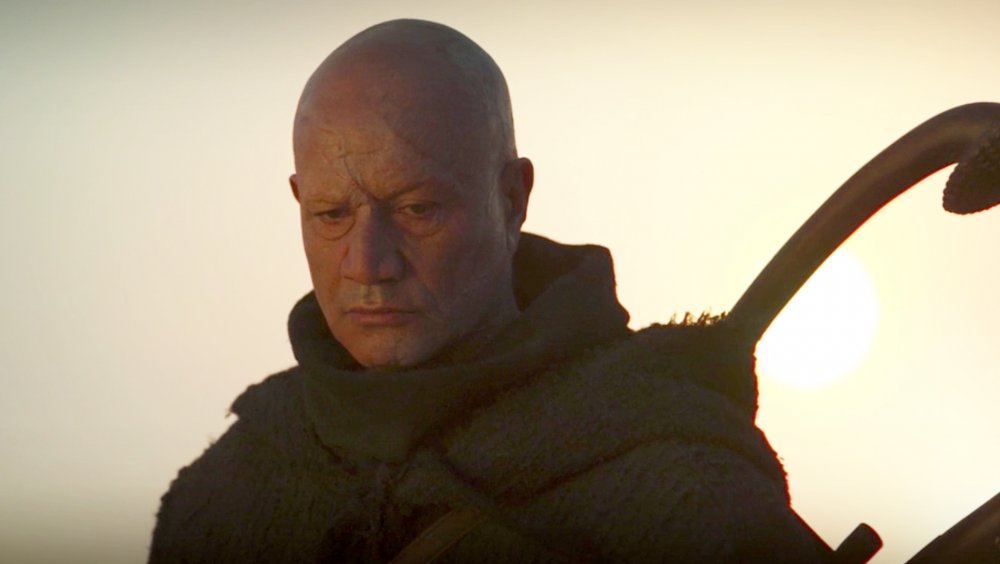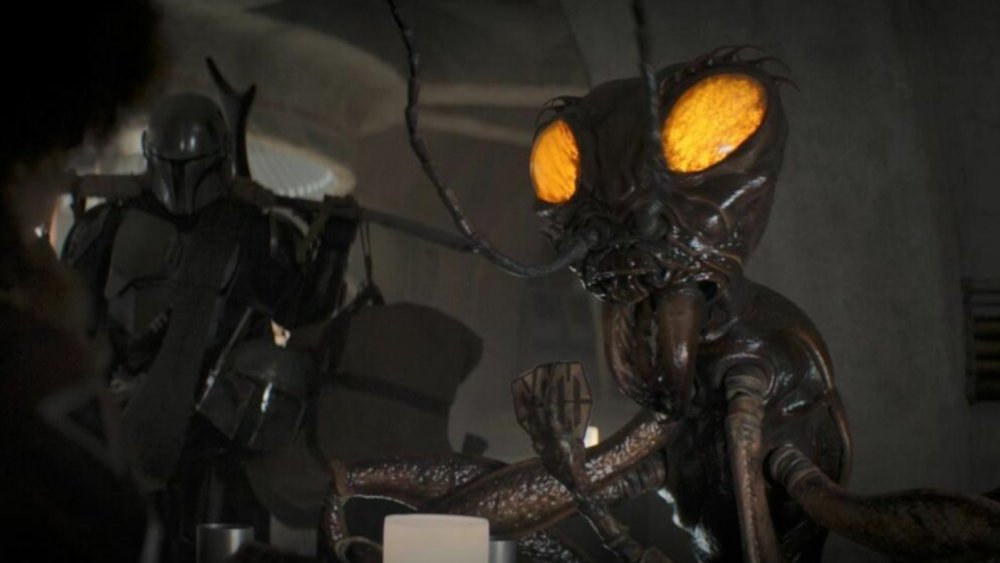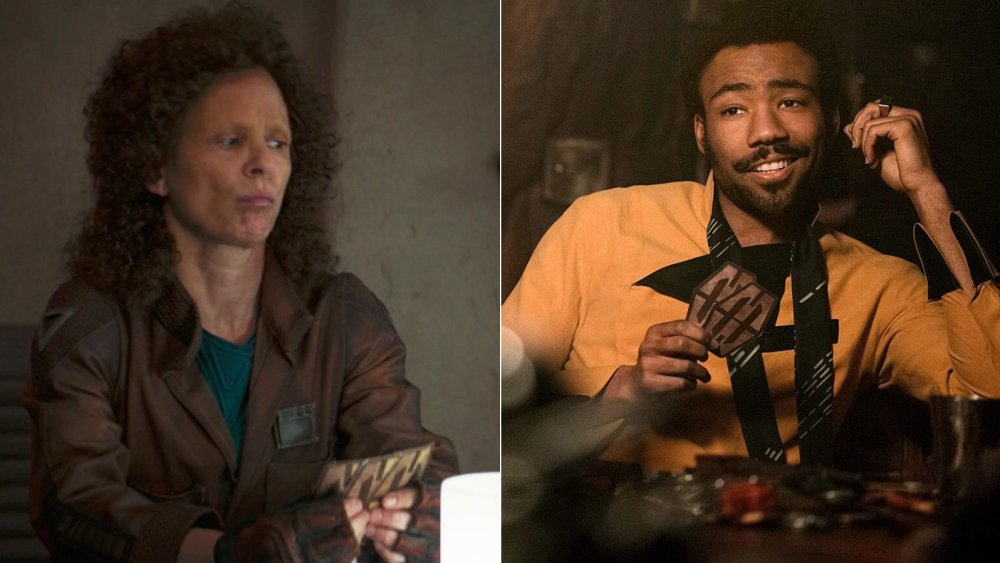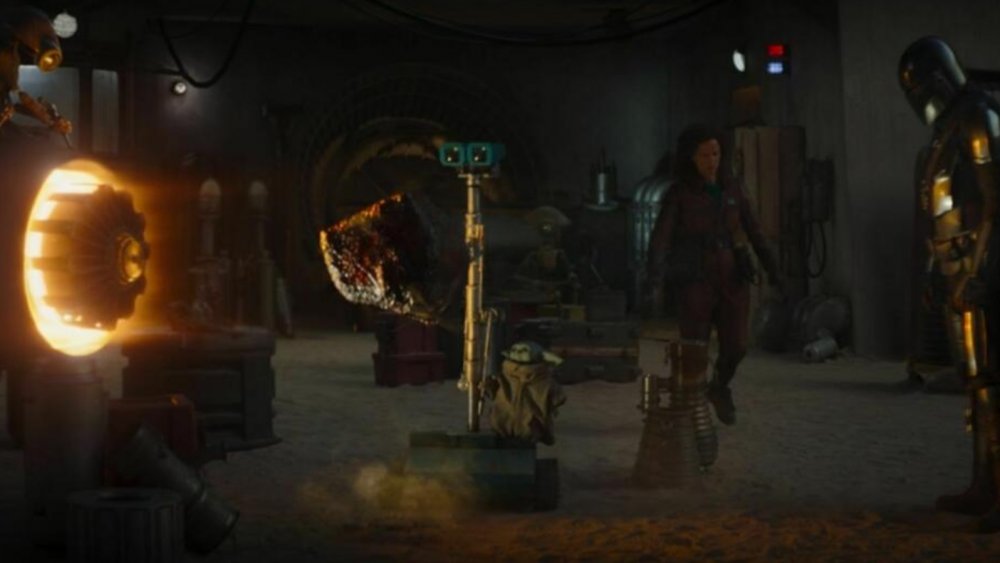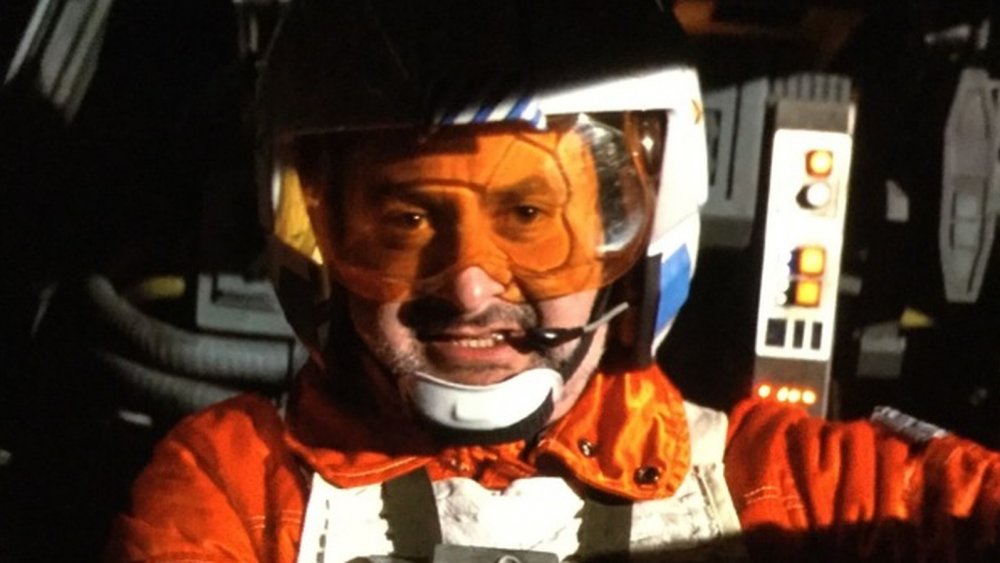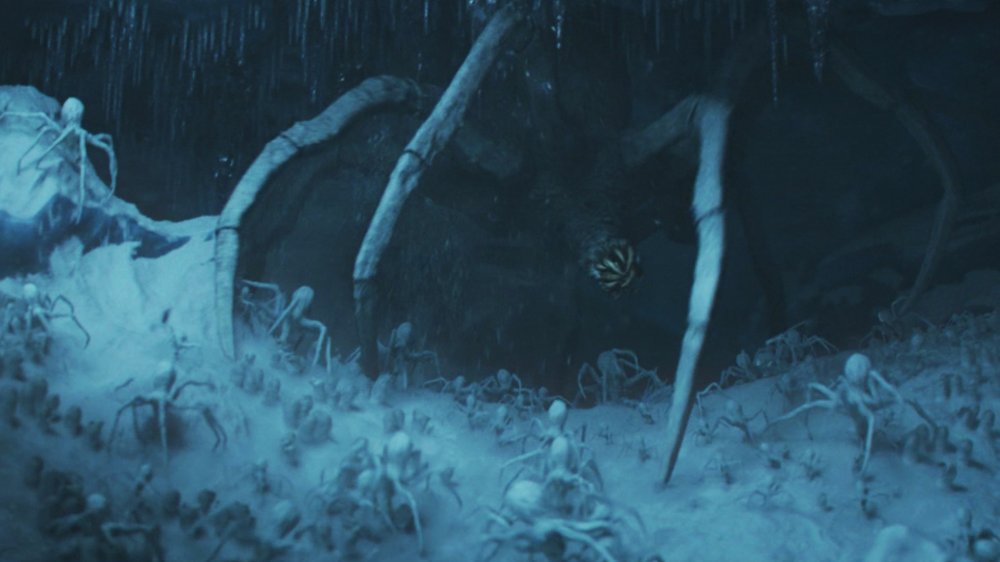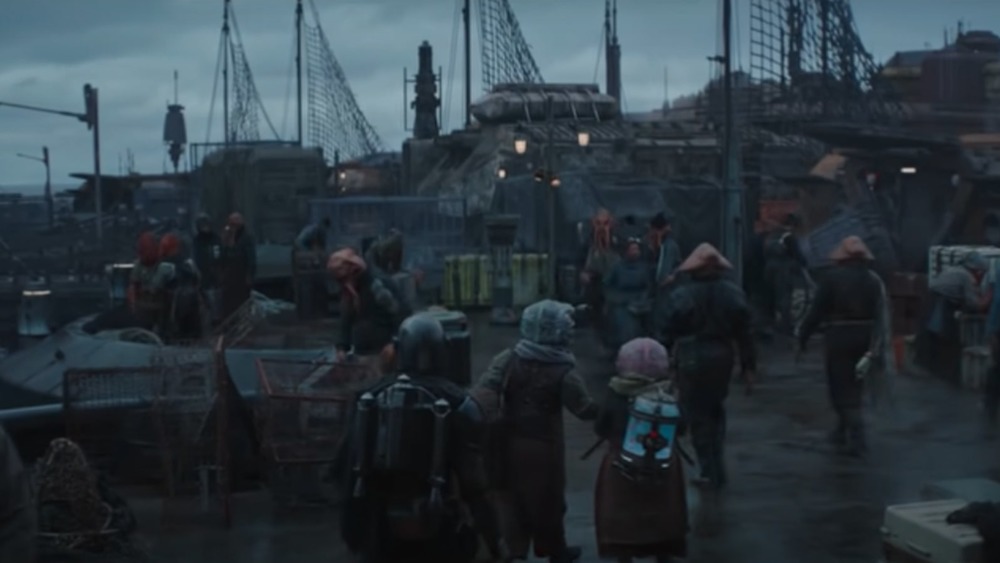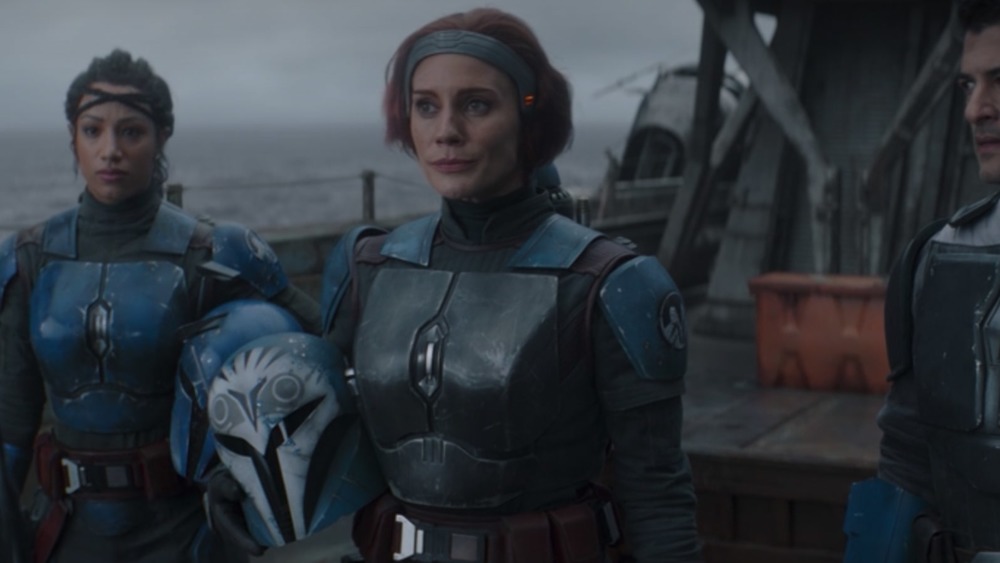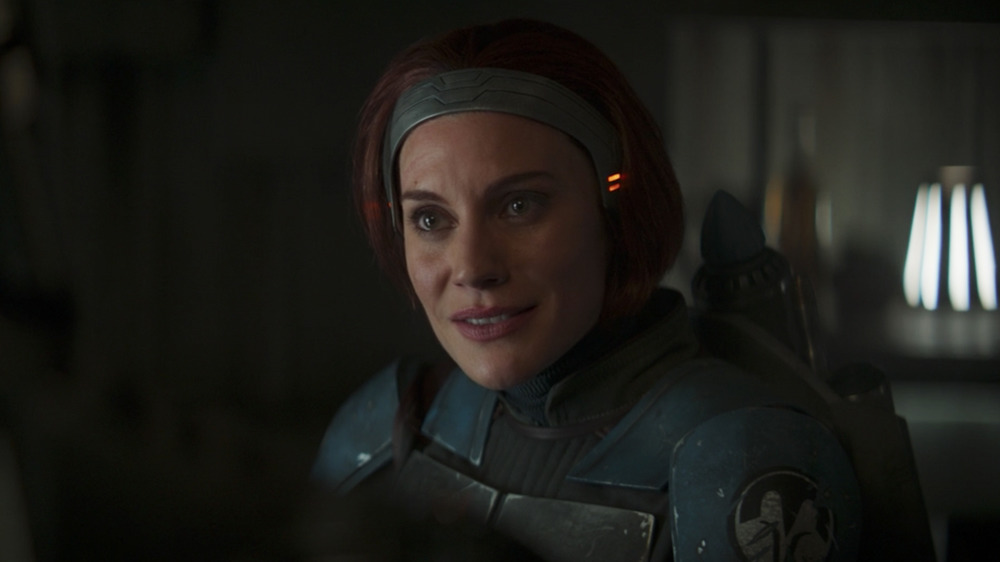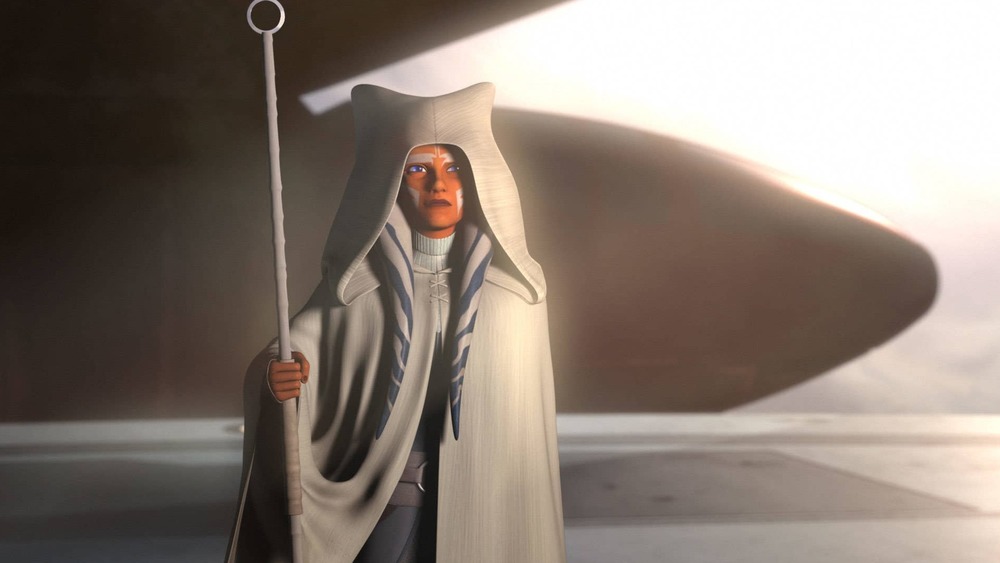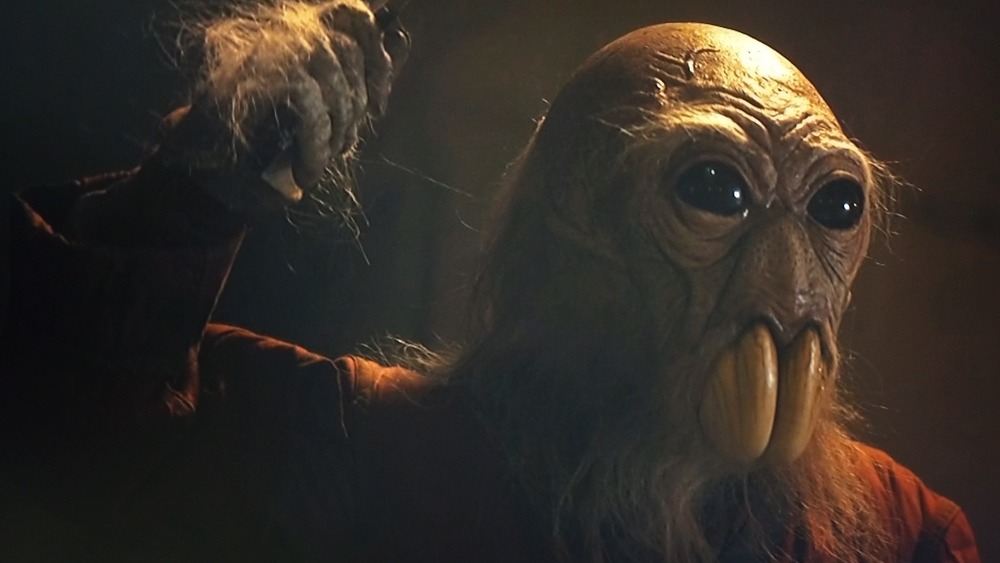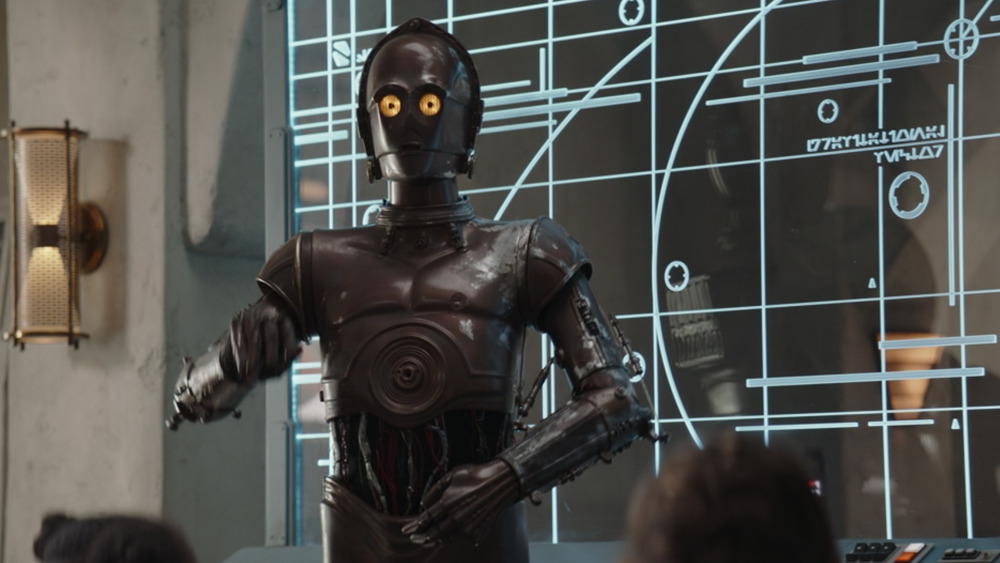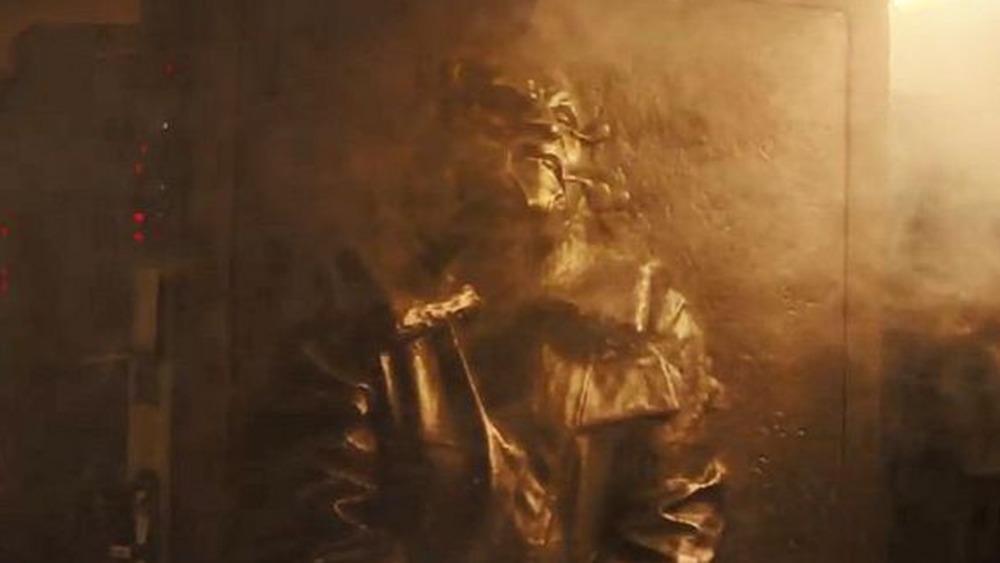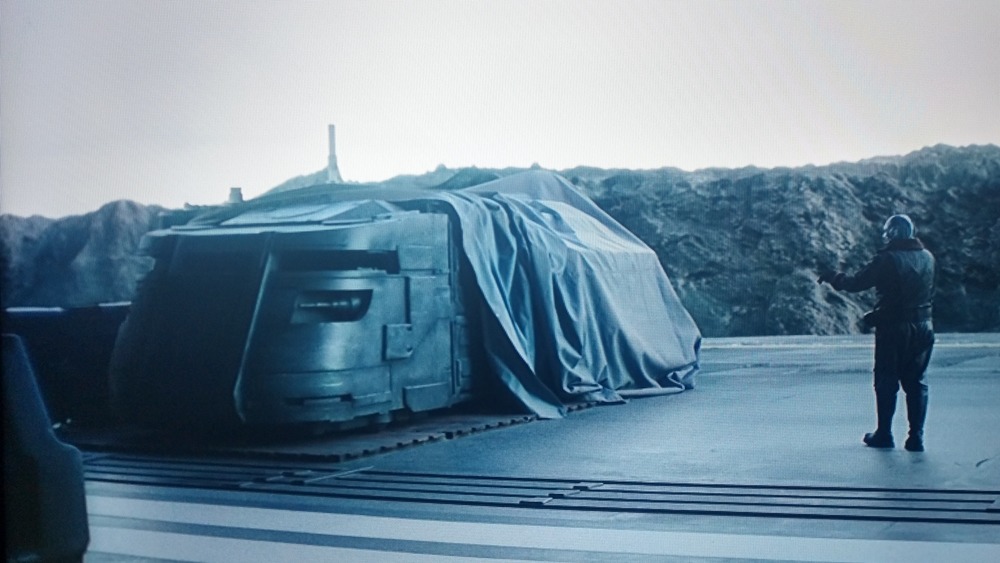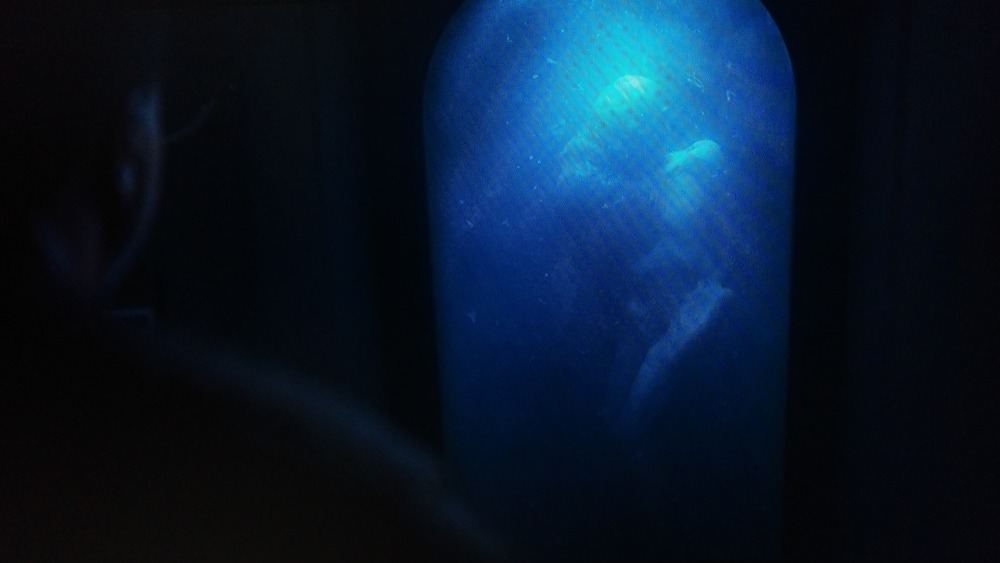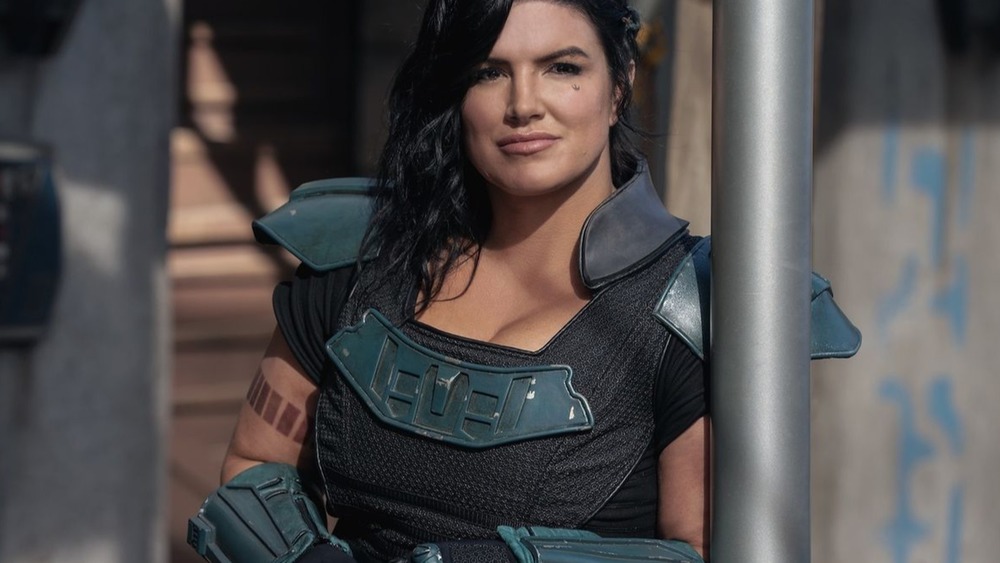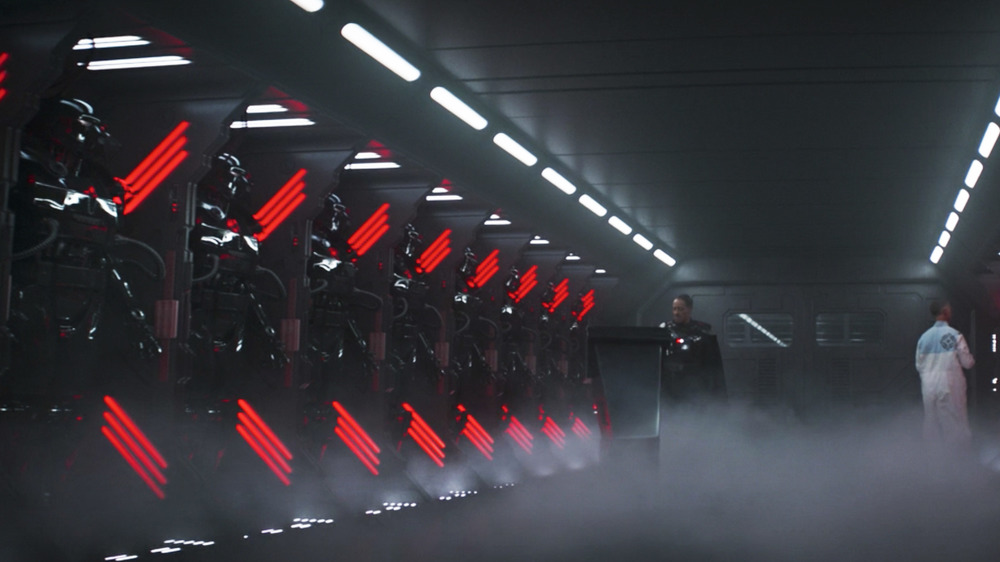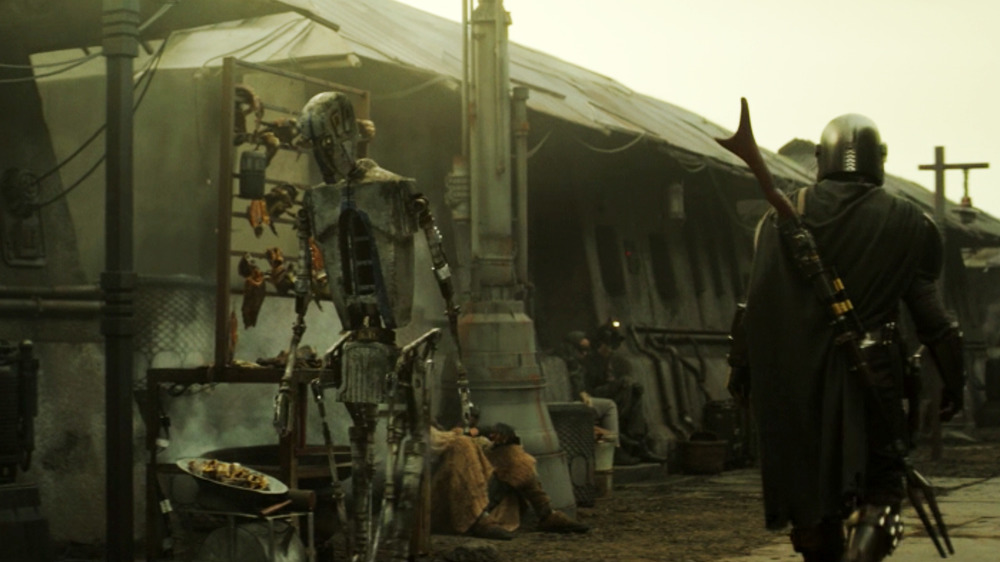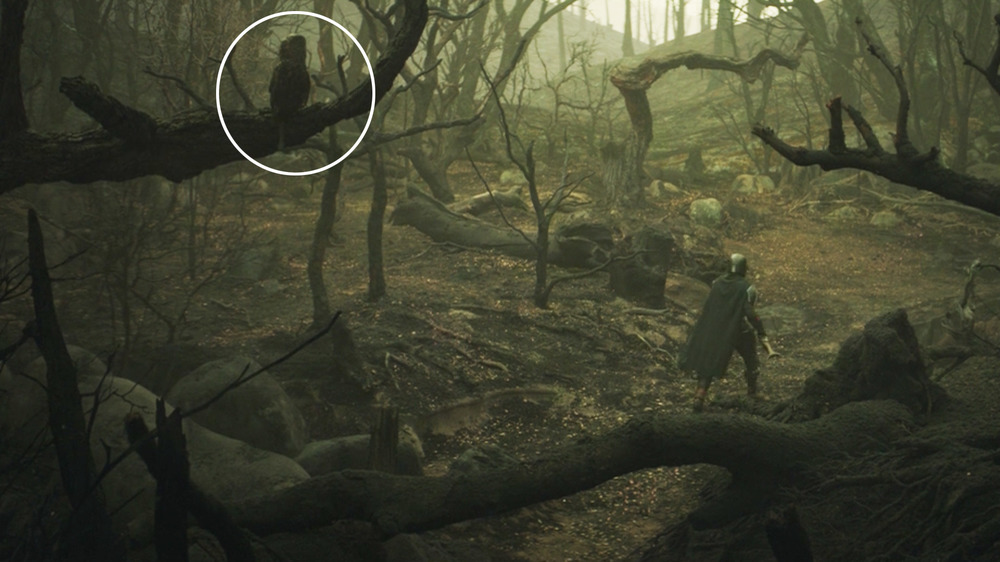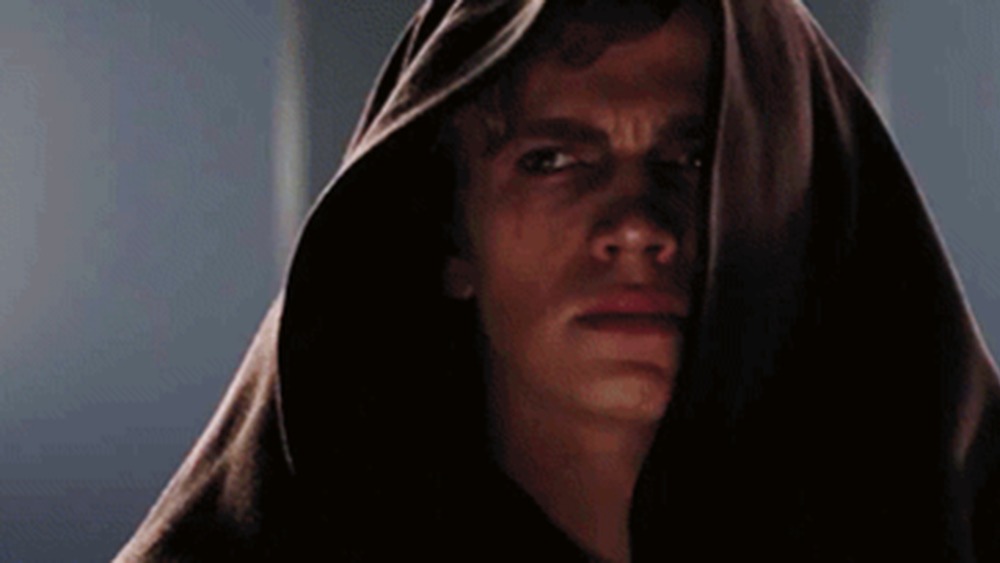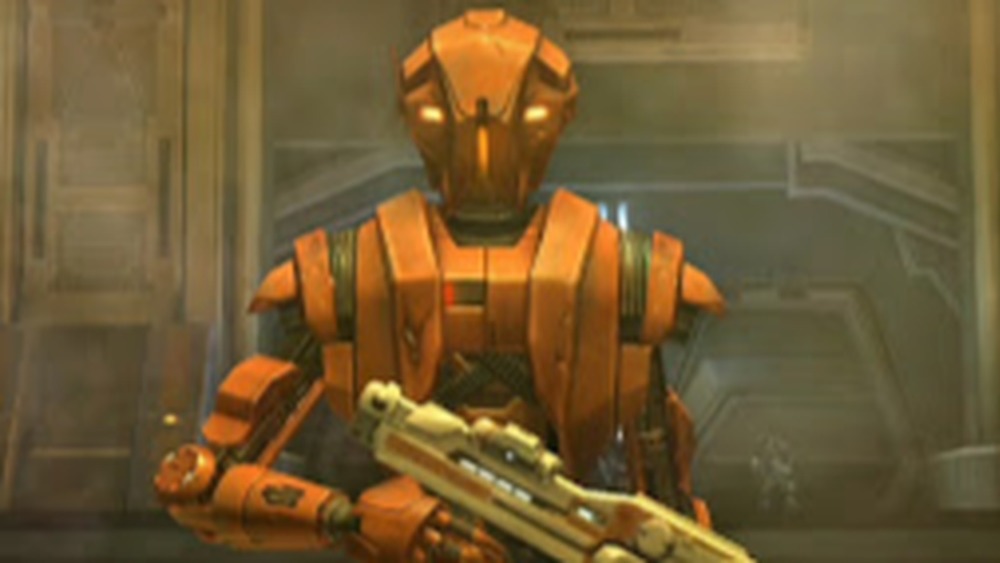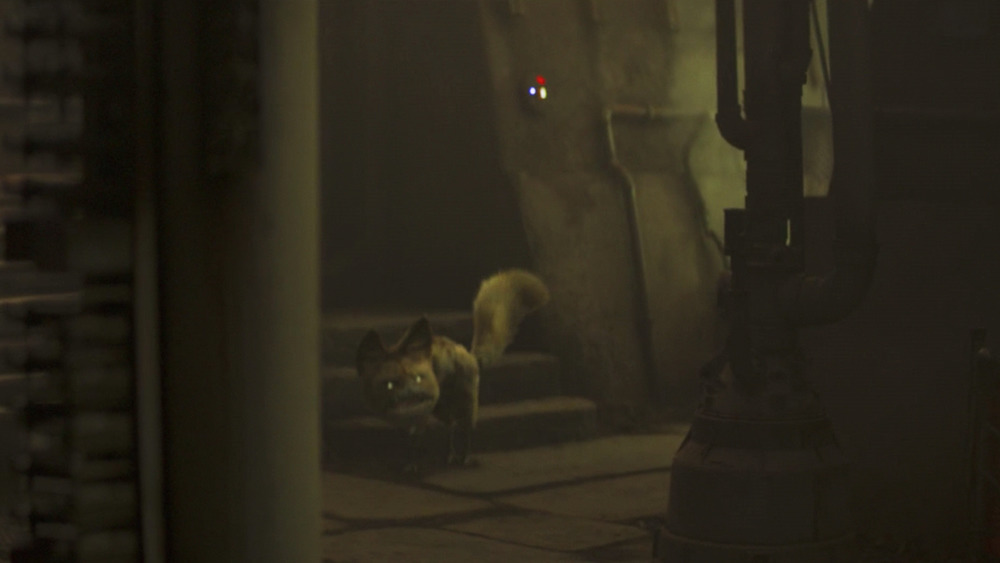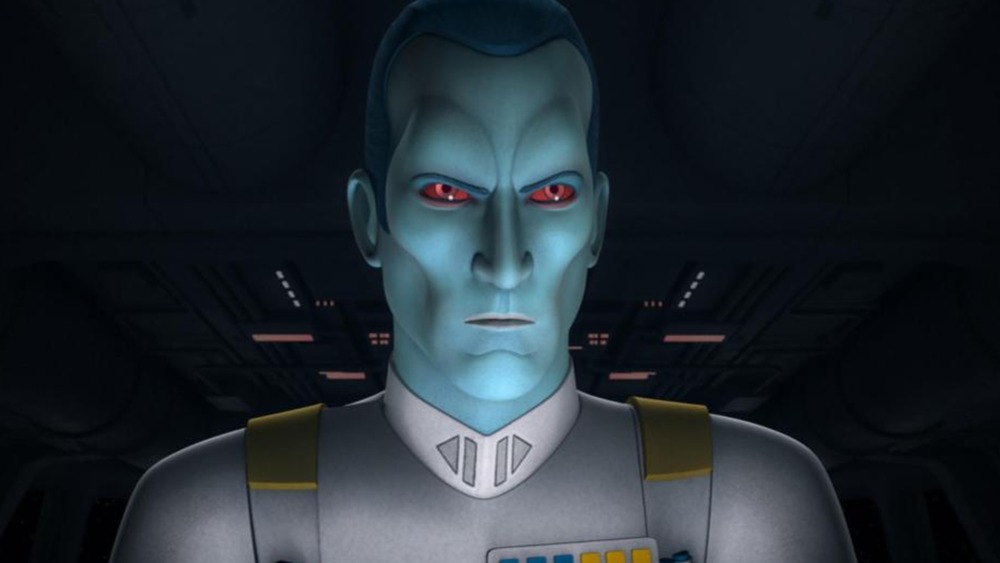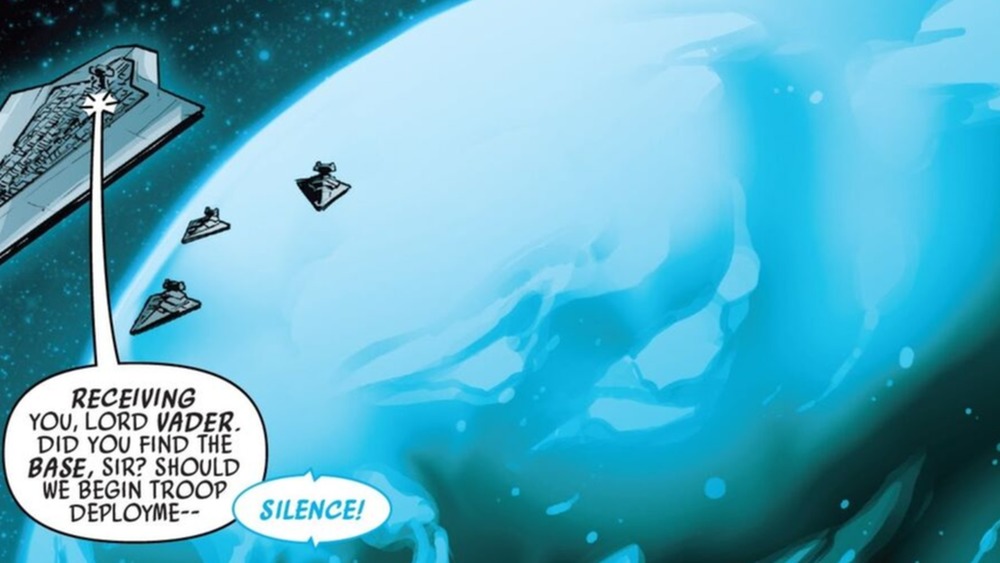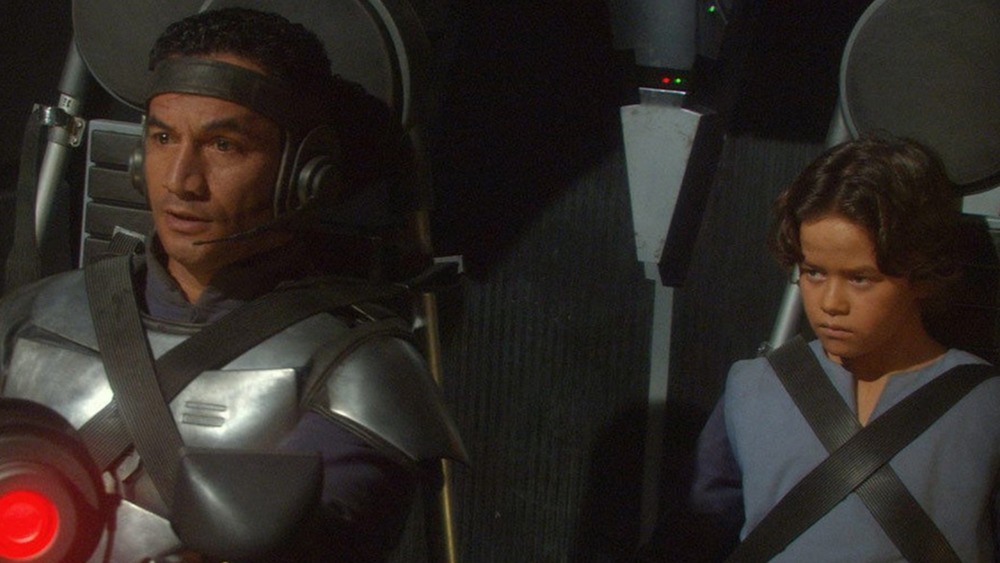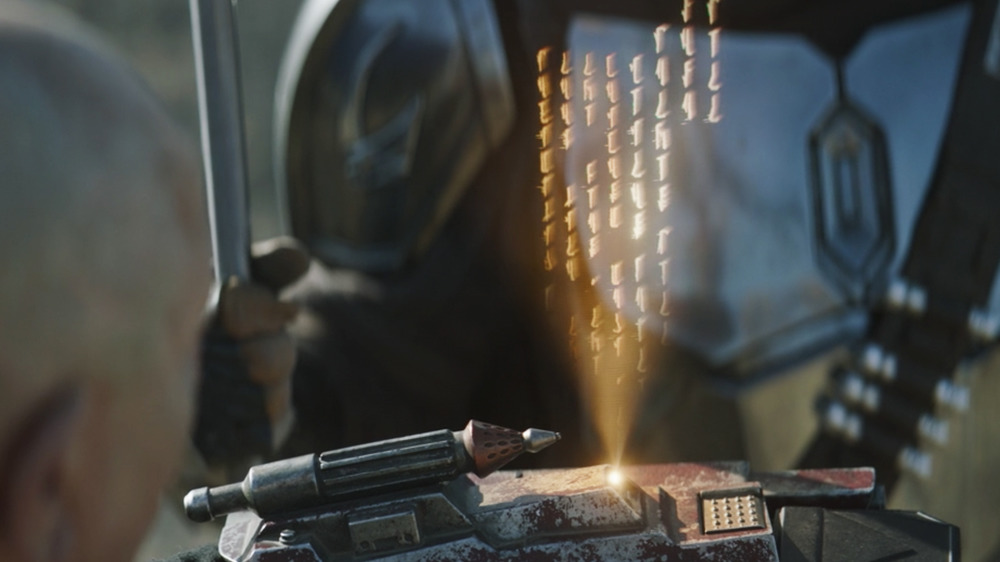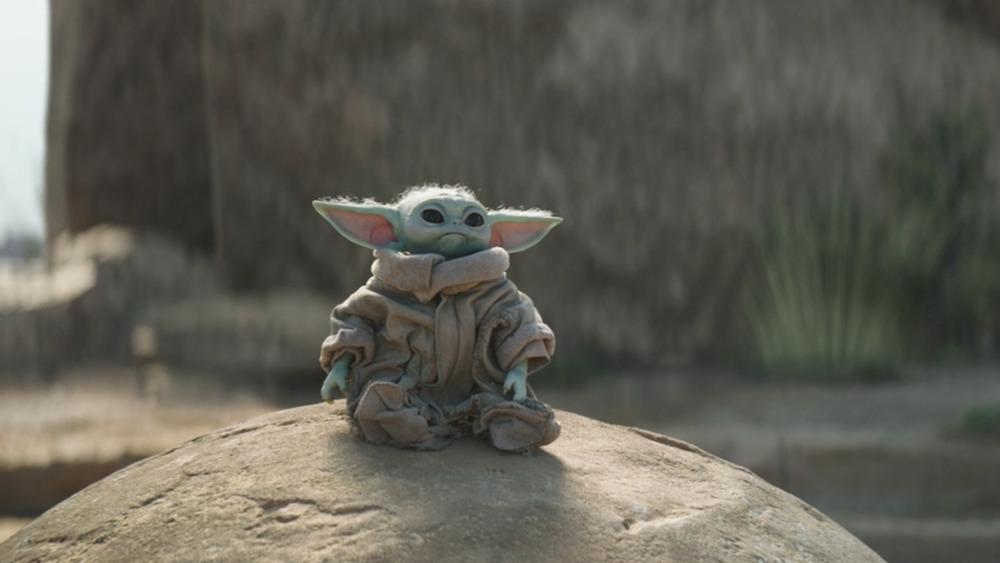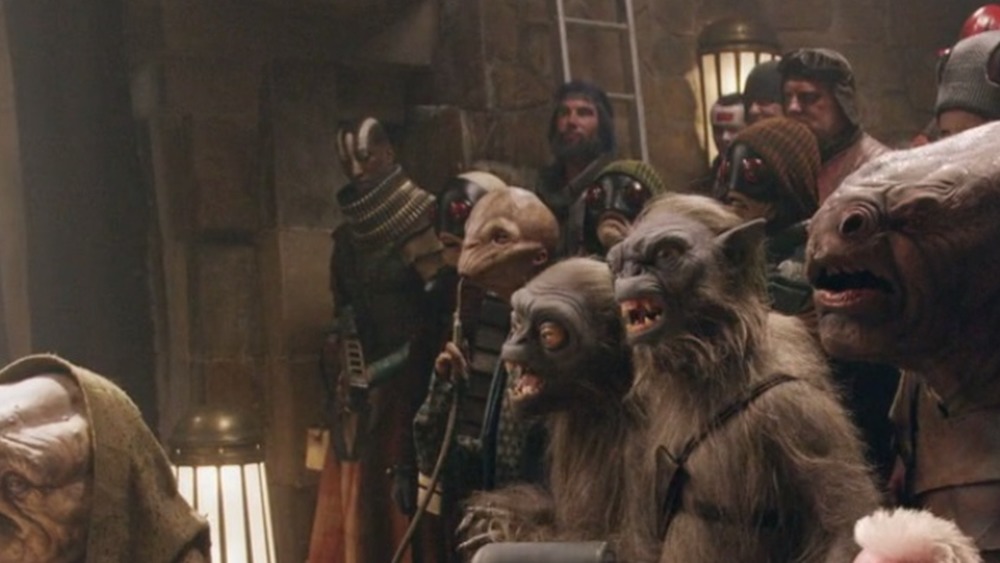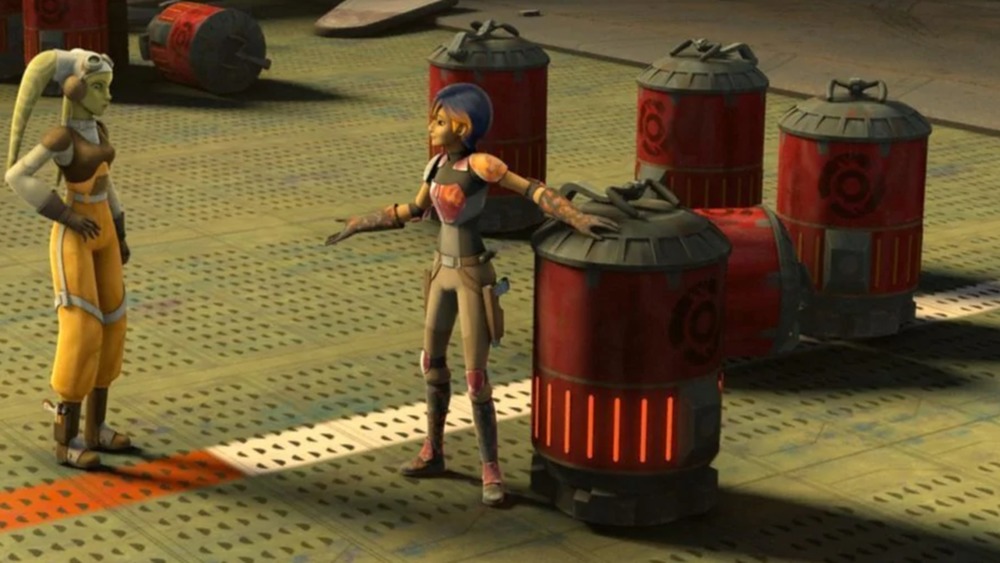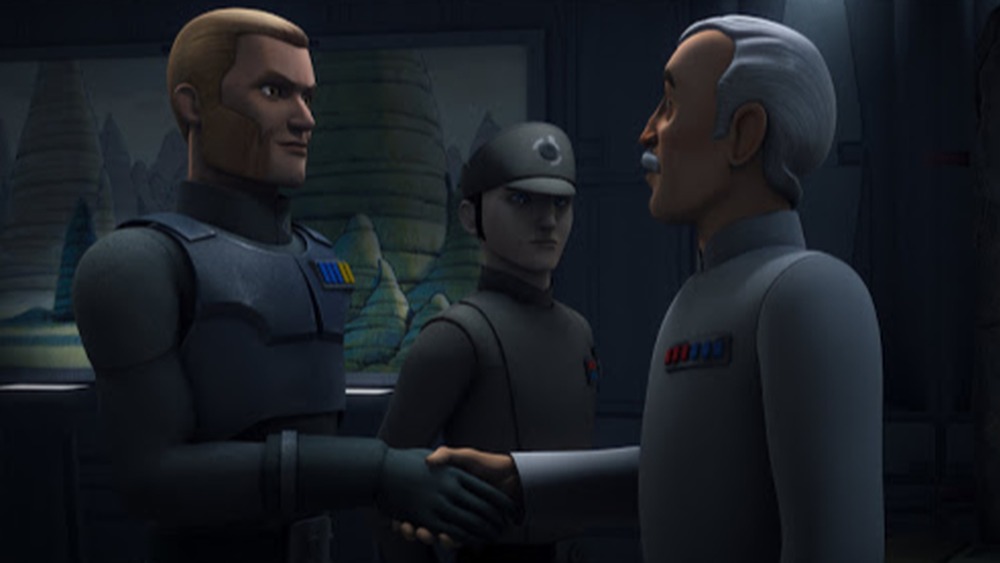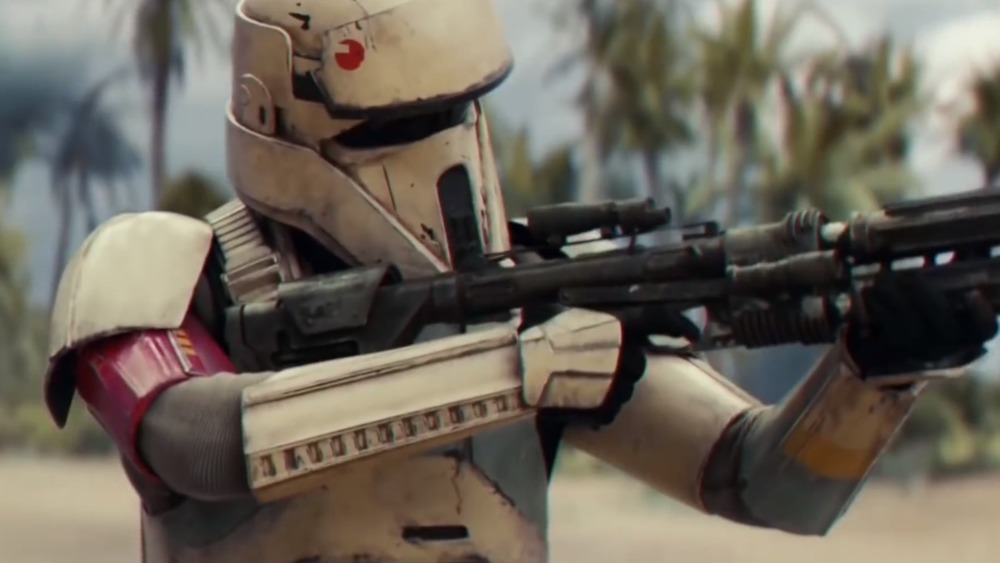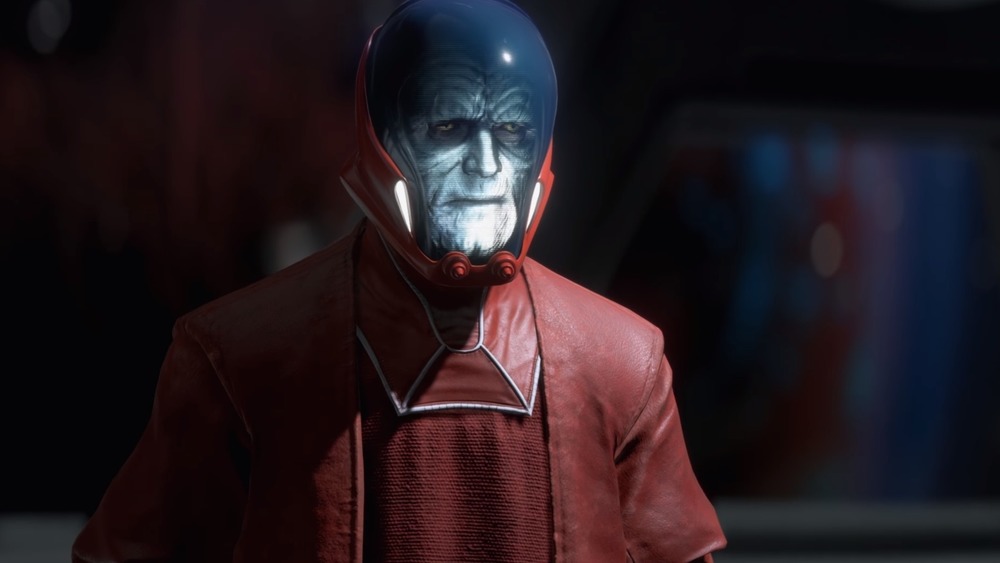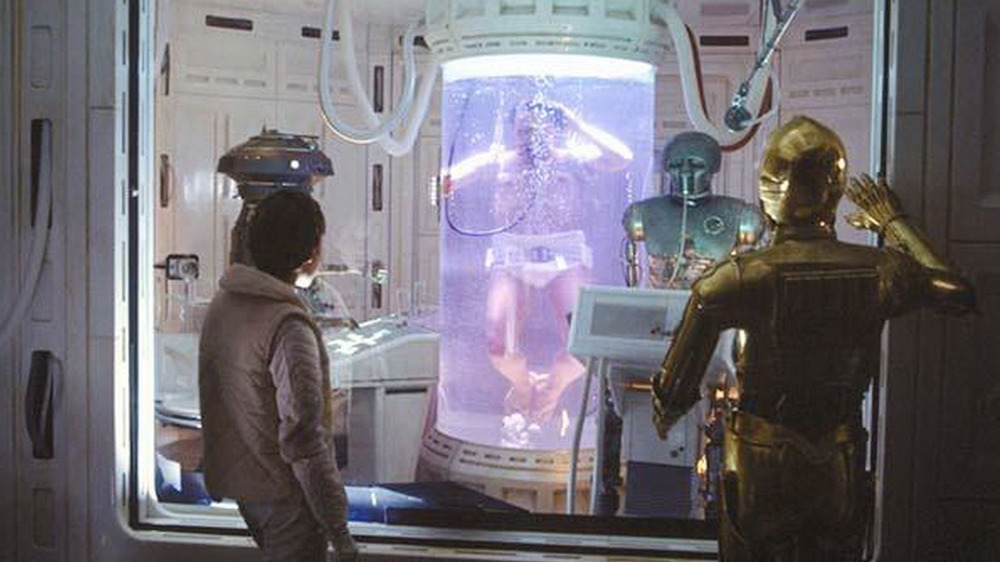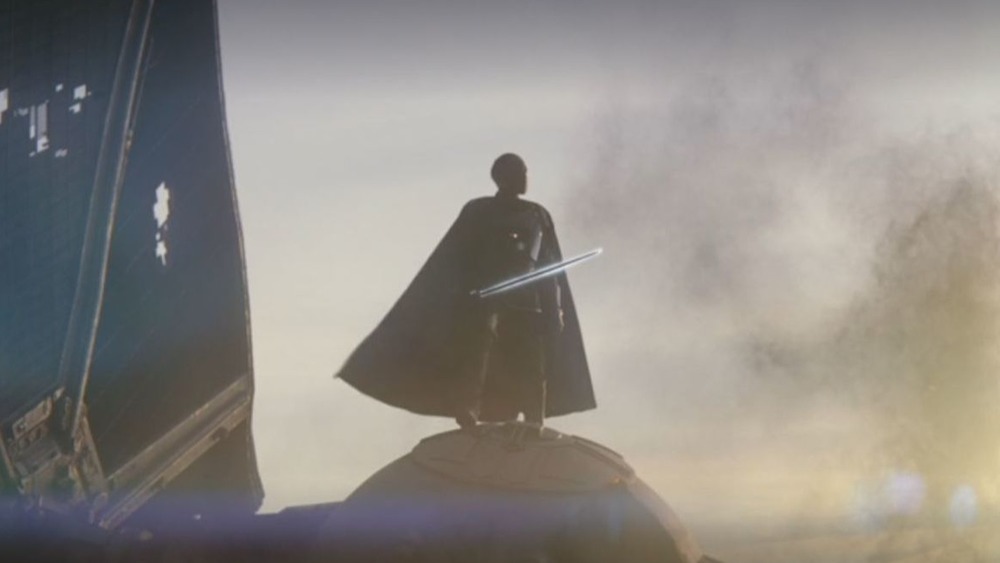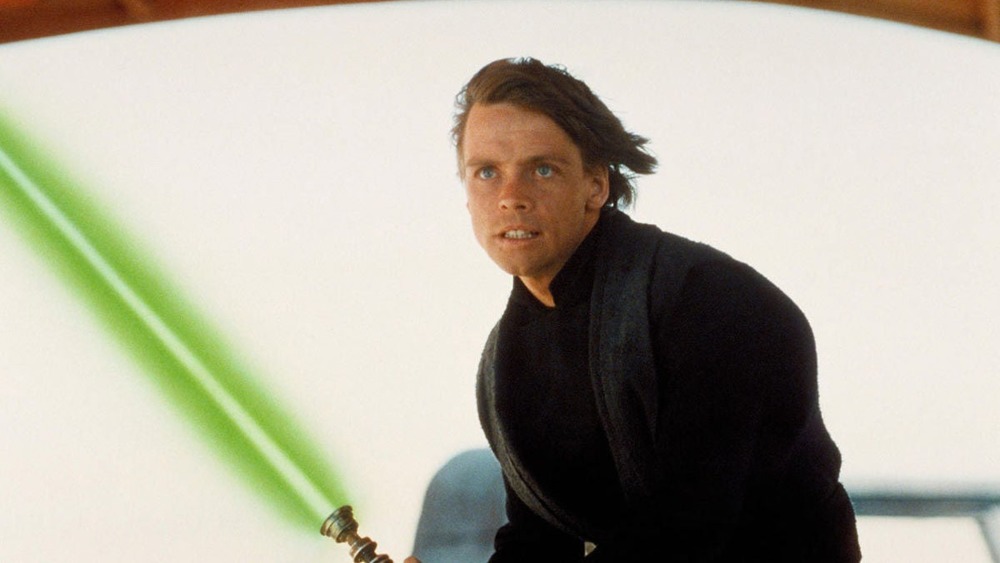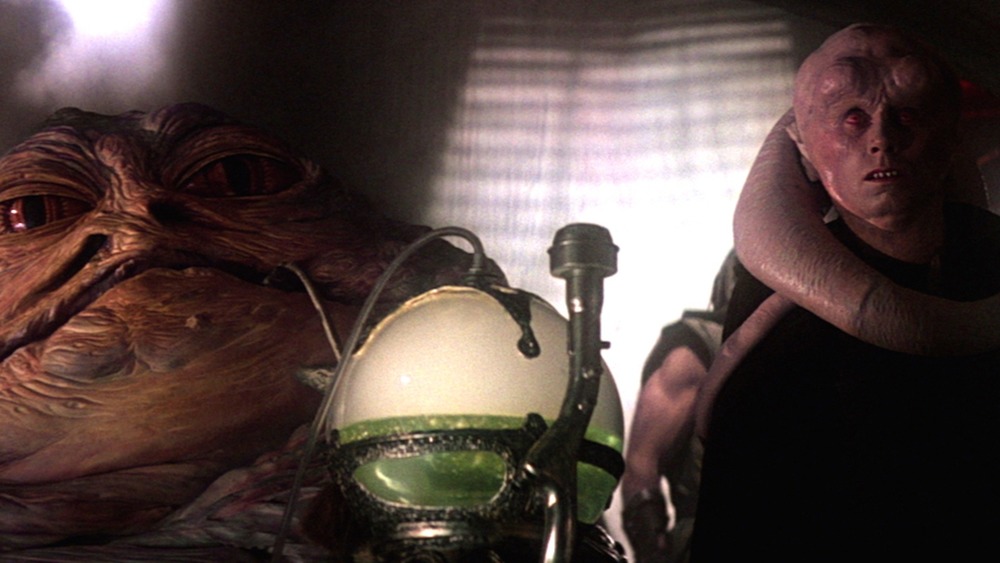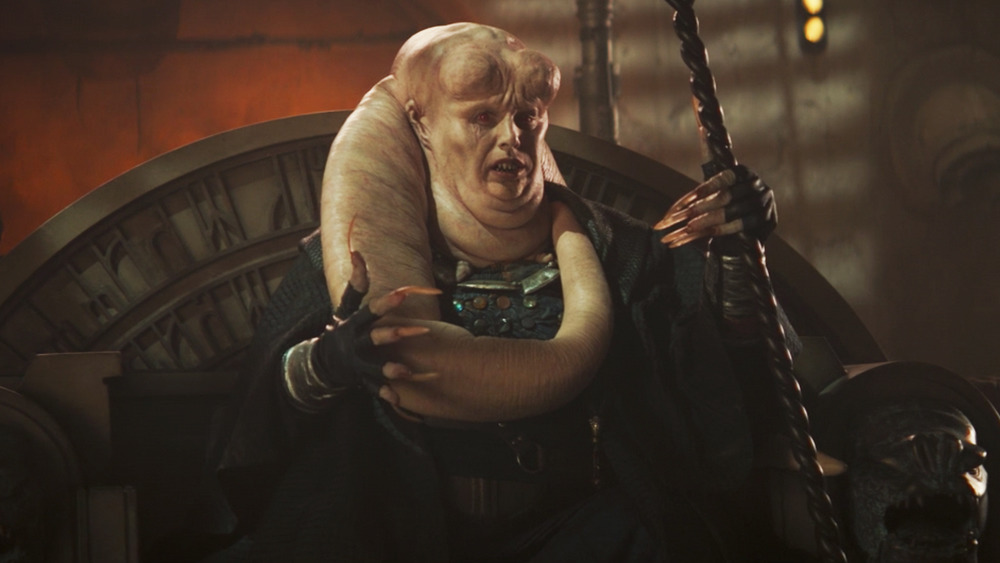Easter Eggs You Missed In The Mandalorian Season 2
Contains major spoilers for The Mandalorian season 2
After nearly a year since its season 1 finale landed on Disney+, the hit Star Wars series The Mandalorian finally made its triumphant return to streaming on October 30, 2020. Following the impressive and incredibly popular inaugural season, the second season is already shaping up to be just as big — if not bigger — than its predecessor. Casting rumors and story speculation have taken over the internet for the better part of the past few months, but now is finally the time for viewers to kick back, relax, and see whether or not their predictions come true as the next eight chapters roll out.
Simultaneously, another fun incentive for tuning in to The Mandalorian is the plethora of Easter eggs the show supplies. The likes of Jon Favreau and Dave Filoni – who are Star Wars fans as much as they are creators — spearhead The Mandalorian, and they don't shy away from deep cuts into the franchise's lore. It looks to carve out its own niche in the established universe, but there are still plenty of small details, references, and cameos to keep die-hard fans skimming through episodes with a fine-toothed comb. The first season excelled in this regard, bringing together aspects of all three Skywalker saga trilogies in a subtle manner while still creating an intriguing and totally original narrative.
In a similar fashion to the initial batch of Mandalorian episodes, season 2 appears equally as plentiful in the Easter egg department. Here are the secrets lurking in the background that you probably missed.
What became of Jabba's palace patrons?
Right off the bat, the season premiere of The Mandalorian season 2, entitled "Chapter 9: The Marshal," kicks off Din Djarin's (Pedro Pascal) journey to find the remaining Mandalorians hidden across the galaxy. He hopes that they can help him relocate the Child (aka Baby Yoda) to wherever he came from and, by extension, lead him to his family as well. However, this won't be a one-and-done task, as the Mandalorian sects are notoriously difficult to locate — meaning the titular bounty hunter has to ask around to locate his people.
The first stop for Mando (the nickname for Din Djarin) is to meet up with an Abyssin — a callback to a Cantina alien from 1977's A New Hope – named Gor Koresh on a seedy, unnamed planet. There, the two converse during some type of combat sport involving two Gamorreans squaring off with Vibro-axes inside something resembling a boxing ring. An appearance from these guys isn't too unexpected, since Favreau shared on his Twitter page last year a picture of a statue of one of them, revealing the Gamorreans' cameo during season 2.
These pig-faced aliens made their Star Wars debut in 1983's Return of the Jedi, posing as guards for the gangster Jabba the Hutt. Alongside them were a handful of Weequay, which just so happens to be the same race as Mos Pelgo's resident bartender. With the underworld kingpin long gone by the time of The Mandalorian, it appears his former palace rogues are doing their best to make ends meet.
R5-D4 is still kicking
After concluding his less-than-cordial meeting with Koresh, Mando and his foundling make their way to Tatooine to look for the supposed Mandalorian wandering the planet's sandy plains. Of course, they can't get a good look around the planet from the Razor Crest, so they enlist the hangar of Peli Motto (Amy Sedaris), who first appeared in The Mandalorian's inaugural season alongside her crew of pit droids. But they're not the only droids running amok in her mechanic area, as a familiar face popped up to help Mando navigate Tatooine's perilous terrain.
Motto stored the map of Tatooine inside an R5 astromech unit that fans of A New Hope likely recognized immediately. In said film, Luke Skywalker (Mark Hamill) goes off to purchase from the Jawas a new droid for the family moisture farm, and the red-and-white R5-D4 was his first choice. Sadly, the little guy didn't get to go off and have galaxy-wide adventures with the future Jedi, thanks to a bad motivator, so that spot went to the fan-favorite R2-D2. It's good to see that Motto could fix him up, even if he's a bit sluggish for her liking.
Callbacks to a variety of Tatooine locations
The vast majority of The Mandalorian season 2's first episode takes place on Tatooine, which is one of the most important locations in the Star Wars universe. Koresh's lead sends Mando to the off-the-grid town of Mos Pelgo, but bookworms would recognize it by another name: Freetown. Chuck Wendig's 2015 novel Aftermath introduced the village, describing it as a dirty, sparsely populated settlement that wasn't for the faint of heart. The Mandalorian's "Chapter 9: The Marshal," however, marks the first appearance of the run-down community in any visual medium, adapting it to near perfection.
Additionally, during her discussion with the Mandalorian about Mos Pelgo, Peli Motto name-drops some other recognizable Tatooine locales as well. First and foremost, she mentions Mos Eisley, a wretched hive of scum and villainy that housed Chalmun's Cantina and took on a pivotal role in both A New Hope and The Mandalorian season 1. Mos Espa, the home of Watto's junkyard and the birthplace of Anakin Skywalker (Jake Lloyd/Hayden Christensen), received a nod too, thus rounding out Tatooine's few major settlements.
Boba Fett returns ... kinda
Upon arriving at the largely unremarkable Mos Pelgo, Mando enters the local cantina to speak with anyone who can provide him with information on the town's supposed Mandalorian resident. For Mando, the result was pretty disappointing. He didn't find one of his people, but rather Cobb Vanth, who was simply wearing the armor with no ties to the creed. It doesn't take a deep knowledge of Star Wars to recognize the gear as Boba Fett's — although, if you only watch the movies and TV shows, you'll have to do some digging to learn about Cobb Vanth.
Vanth, as portrayed by Deadwood star Timothy Olyphant, made his debut in the Star Wars universe in the aforementioned Aftermath novel. The book details his journey pretty vaguely, running over the broad strokes of him receiving the armor from the Jawas and subsequently saving Freetown from marauders and Tusken Raiders, thus earning the moniker "The Marshal" — hence why the season 2 premiere bears that name in its title. The Mandalorian certainly picks up the slack, putting Vanth front and center with a series of flashbacks to supply a bit more detail than a few book pages could pull off.
The Krayt Dragon makes a terrifying entrance
Committed as ever to his beliefs, Mando refuses to allow Vanth to keep the Mandalorian armor since it technically doesn't belong to him. Since both of them are rational men, they come to an agreement that will service both parties. Mando can have every last piece of armor so long as he helps Vanth take down, once and for all, the carnivorous beast known as the Krayt Dragon that's ravaged Mos Pelgo for years. They might not realize what they're dealing with, but longtime Star Wars fans instantly recognized the danger the two were in.
Krayt Dragons are as old as Star Wars itself, first appearing in the background of A New Hope. After C-3PO (Anthony Daniels) and R2-D2 crash-land in the middle of the Dune Sea, a Krayt Dragon skeleton sits in the sand way off in the distance. Despite holding a constant, menacing presence across all forms of media, Krayt Dragons — live ones, anyway — are an incredibly rare sight throughout the canon. Most of the time, the story relegates them to a fleeting mention or a set-piece used to fill in space, even though they're massive beasts with highly valuable pearls in their bellies. However, if the Krayt Dragon's arrival on The Mandalorian season 2 proved anything, it's that these long-tenured yet infrequently seen creatures are no joke.
Now this is podracing!
After making their agreement, Cobb Vanth and the Mandalorian make their way across the Dune Sea in pursuit of the Krayt Dragon. Such a long stretch of sand and scorching heat is impossible to trek on foot, so the two found alternative transportation to reach their destination. Mando rides off on the same speeder bike he borrowed from Peli Motto, but Vanth pulls up in something quite out-of-the-ordinary.
His makeshift vehicle sported two large flaps on the front, covering a turbine set below them, with a seating area attached to the rear. This hodgepodge of components calls back to The Phantom Menace's pod racers, sporting a similar look to young Anakin's model. There's no way to confirm if it came from his specifically, but the pieces undeniably came from someone's pod racer.
Life on Tatooine isn't easy for really anyone — whether you're a bounty hunter seeking your next job, or a moisture farmer trying to break even. It's not a glamorous place to live, nor is it the most up-to-date with the rest of the galaxy, being that it's deep in the Outer Rim Territories. Therefore, the planet's occupants need to make do with what they have, using whatever they can scrounge up to stay alive. In the case of Cobb Vanth, that survival tactic presents itself through his speeder made out of recycled pod racer parts.
Boba Fett returns ... for real this time
With the Krayt Dragon defeated, Cobb Vanth keeps his word and returns the Mandalorian armor set to Din Djarin. The episode concludes with the two parting ways as allies, and the beskar-clad bounty hunter rides off into the sunset with the Child at his side, per usual. The episode's story looked complete there, but there was one last surprise left for the fans. By far the biggest Easter egg of The Mandalorian's season 2 debut came in the form of the most fearsome bounty hunter to ever live: the legendary Boba Fett, played by Temuera Morrison.
From the moment of The Mandalorian's conception, audiences have clamored for Fett to make his big comeback on the show at some capacity. After all, he and the series' main character are incredibly visually similar and they're in the same profession, so a crossover felt like a given. The previous season didn't do much to satiate this subset of fans, but thankfully for them, season 2 is going all-in. For the past number of months, news outlets reported on Morrison's casting and lit the social media world ablaze, building serious anticipation for the show going forward. Now, at long last, Jango Fett's clone son is once again making his way to the forefront of the Star Wars universe — and by the looks of things, he's in no mood to make friends.
Enter Dr. Mandible
After returning from the successful Krayt Dragon hunt, the Mandalorian returns to Mos Eisley in "Chapter 10: The Passenger" to meet with Peli Motto. He reports back and lets her know that the supposed Mandalorian frequenting Mos Pelgo was just a man in Mandalorian armor, but she reassures him that she can put him in contact with someone who can lead him to his people. First, she introduces him to a brand-new character named Dr. Mandible: a giant, bug-like creature whose brief screen time carries with it a couple of meanings.
For one, Dr. Mandible appears to be a member of the Killik species first introduced in the now-Star Wars Legends Dark Nest trilogy of books by Troy Denning. A member of the Killik species that may have been Dr. Mandible himself briefly popped up in the background of a previous episode of The Mandalorian — season 1, episode 5 — where they were seen sitting at the Cantina bar.
It's also worth noting that filmmaker Peyton Reed — best known for films such as The Break-Up and, of course, Ant-Man — directed "Chapter 10: The Passenger." Thus, the inclusion of this ant-inspired character seems a not-so-subtle nod to the director's Marvel Cinematic Universe contributions.
Anyone for some sabacc?
When Mando first gets back to Mos Eisley after a long, strenuous walk across the desert, his first stop is at the local Cantina — the very same one from A New Hope — where he finds Motto in the middle of a high-stakes card game against Dr. Mandible. The scene doesn't last long, and their game isn't the focus by any means, but the cards in Motto's hands point to one of the Star Wars universe's favorite pastimes: a good old-fashioned game of sabacc.
Sabacc is a staple of Star Wars – appearing in everything from books, TV shows, video games, and, obviously, a few of the movies. It's mentioned now and again throughout the Skywalker saga, even popping up in the background of Star Wars: The Force Awakens, but its most notable appearance came in 2018's Solo: A Star Wars Story. In the film, a young Lando Calrissian (Donal Glover) cheats a young Han Solo (Alden Ehrenreich) out of a game, but the Corellian smuggler later gets his future ally back by using his techniques against him to steal a win, walking away with the Millennium Falcon.
Barbecuing in a galaxy far, far, away
Just before departing for Trask, Mando and the Child wait inside Peli Motto's hangar for their passenger to arrive. As a token of their appreciation, they leave her with a portion of the Krayt Dragon meat they secured in the previous episode, which she cooks up rather peculiarly. A WED-15 Treadwell droid holds up the cut of meat before the flames of a stationary podracer engine to roast it, referring back to a real-life Star Wars eatery located at Disney's Galaxy's Edge theme park.
The restaurant in question is Ronto Roasters — a neat little place with a menu including something for everyone. While Ronto Roasters doesn't have any Krayt Dragon steaks for sale, one of its more decorative elements draws a neat parallel to this Mandalorian scene. At the heart of the diner, you can watch droids "cook" food beneath a podracer engine in the same fashion as Motto's droid. Even though it's all for show at the amusement park, it's nice to see this method of food preparation make its way into Star Wars canon proper.
Trapper Wolf, standing by
Mando and the Child's journey with their passenger, the Frog Lady (voiced by the legendary Dee Bradley Baker), and her container of eggs becomes a bit complicated since they can't utilize hyperspace travel for the sake of her unborn children. Instead, they have to make the journey to the planet Trask at sublight — meaning that anyone looking for the titular Mandalorian, for better or worse, will have a much easier time finding him. That includes the New Republic's X-wing patrols, who press the bounty hunter relentlessly for information about his ship and his shady dealings.
One pilot in particular likely stood out to seasoned Star Wars fans from the moment he arrived on-screen. The mastermind behind both Star Wars: The Clone Wars and Star Wars Rebels and an occasional Mandalorian director Dave Filoni makes a brief appearance in "Chapter 10: The Passenger" in a reprisal of his Mandalorian season 1 role, Trapper Wolf. The character made his franchise debut in the episode "Chapter 6: The Prisoner," in which he — alongside fellow directors Deborah Chow and Rick Famuyiwa — destroys Ranzar Malk's (Mark Boone Junior) space hangar following the escape of New Republic prisoner Qin (Ismael Cruz Córdova).
The eight-legged terror of the Krykna
Following their crash-landing in the Razor Crest, the Mandalorian, the Child, and the Frog Lady are left to survive in the bitter cold of an unnamed ice planet. Fed up with Mando's sluggishness in repairing the ship, the Frog Lady wanders off into the snowy labyrinth and finds a hot spring for herself and her eggs to unwind for a bit. Concerned for their safety, Mando comes to let her know she needs to return to the ship, and his hunch was right. In a scene akin to something from Ridley Scott's Alien, the Child unintentionally awakens a den of spider-like creatures known as the Krykna.
The Krykna have a long, storied history in the Star Wars universe, first realized in legendary concept artist Ralph McQuarrie's The Empire Strikes Back sketches and initially known as the Knobby white spiders of Dagobah. While they never appeared in that film, the Krykna eventually made their spine-tingling entrance during Star Wars Rebels' second season, in the episode "The Mystery of Chopper Base." They later appeared in a handful of other installments of the series, but their introduction on The Mandalorian is their first in live-action — and, for those with arachnophobia, hopefully their last.
Quarren and Mon Calamari take center stage
The third episode of The Mandalorian's second season, entitled "Chapter 11: The Heiress," brought the titular bounty hunter and his little green counterpart to the estuary moon of Trask, completing their mission to deliver the Frog Lady and her children back to her husband. After the pair makes a bumpy landing on one of the moon's sea-bound ports, the episode offers a closer look at its many residents — the bulk of whom belong to the Mon Calamari and Quarren species. At this point, both of these aquatic alien races are incredibly prevalent in Star Wars media, dating back to the original trilogy.
Both the Quarren and the Mon Calamari joined the universe in Return of the Jedi, although they appeared in drastically different places. The aptly named "squid heads" were prominent background entities during the Jabba's Palace scenes, while the film introduced the Mon Calamari as key members of the Rebellion during the Battle of Endor — the most famous among them being the legendary Admiral Gial Ackbar (Erik Bauersfeld), who remained a part of the faction until he died in 2017's Star Wars: The Last Jedi.
Additionally, a season 4 arc of Star Wars: The Clone Wars put their conflict on their home world of Mon Cala front and center, and 2016's Rogue One: A Star Wars Story also bolstered the Mon Calamari's standing in the Rebellion's ranks with the introduction of Admiral Raddus (Stephen Stanton/Paul Kasey).
For the both of them, this actually isn't their first appearance in The Mandalorian. In the opening scene of the series premiere, a Quarren was seen being sliced in half by a door, courtesy of Din Djarin. Greef Karga (Carl Weathers) also offered Mando a Mon Calamari bounty in a later episode.
Bo-Katan to the rescue
After chartering a ship to go find more Mandalorians, Mando and the Child are betrayed by their Quarren sea captain, who attempts to feed the little one to a monstrous mamacore, drown Mando, and thieve his valuable Beskar armor. Thankfully for both of them, they're rescued in short order by a group of blue-and-gray-clad Mandalorians — including franchise newcomers Axe Woves (Simon Kassianides) and Koska Reeves (Mercedes Varnado, better recognized as WWE's Sasha Banks) — who are led by fan-favorite character Bo-Katan Kryze, portrayed by her longtime voice actress Katie Sackhoff for the first time in live-action.
Bo-Katan arrived in the Star Wars universe during the fourth season of The Clone Wars as Death Watch leader Pre Viszla's (Jon Favreau) right-hand woman. With Pre Viszla's later demise at the hands of Maul (Sam Witwer), Bo-Katan and a group of Mandalorians split off from the faction and formed the Mandalore resistance, playing an integral role in the Siege of Mandalore during The Clone Wars season 7. Following the fall of the Galactic Empire, Bo-Katan's exploits were shrouded in relative mystery, as her story drops off after her brief appearance in Rebels. However, it appears that The Mandalorian will rectify that, finally giving audiences the answers they desire about her whereabouts and motives in a post-Imperial world.
The quest for the Darksaber
In the Mandalorian season 1 finale, Moff Gideon (Giancarlo Esposito) unveiled his weapon of choice — the ancient Mandalorian Darksaber — to the world by cutting through the wreckage of his downed TIE fighter to escape. Since that moment, viewers have wondered how exactly this top-ranking Imperial official wound up with the artifact, especially since there's currently no media hinting at how he retrieved it and who he took it from. Before its reemergence, however, Bo-Katan was the last person shown wielding it — in Star Wars Rebels after Sabine Wren (Tiya Sircar) handed it over to her. Any specifics detailing how she lost it have yet to come to light, though.
"Chapter 11: The Heiress" went a long way in solving this mystery through a bit of key dialogue from Bo-Katan that hints to a previously untold Star Wars story. After she and her crew fight their way to the bridge of an Imperial shuttle, Bo-Katan interrogates the head officer (played by Deadwood alum Titus Welliver) and demands to know Gideon's whereabouts. She doesn't get any information out of him before he takes his own life, but she does allude to some kind of shared history between him and herself surrounding the Darksaber. Hopefully, the show will expand more on how the weapon slipped from her hands into Gideon's at some point after her Rebels cameo.
Ahsoka lives!
After successfully hijacking the shuttle with Bo-Katan and her allies, Mando departs to continue his mission of delivering the Child to its people, but not before asking his fellow Mandalorian where he can find the Jedi she claimed to know. Grateful for his aid, Bo-Katan tells him to travel to the city of Calodan on the forested planet of Corvus to locate another animated favorite, Ahsoka Tano. The debut of Anakin Skywalker's former Padawan in live-action is a long time coming, with speculation over Rosario Dawson's casting as Ahsoka running rampant for months, and the circumstances surrounding her imminent arrival couldn't be more satisfying for die-hard Star Wars fans.
Having initially squared off as enemies, Bo-Katan and Ahsoka allied during the Siege of Mandalore, as detailed on the Clone Wars' seventh season. Once the Jedi Order disbanded and Order 66 went into full effect (leading Ahsoka to go into hiding), the status of their coalition grew murky, but it seems that they retained some method of contact throughout the Galactic Civil War and in the midst of the Empire's collapse. Also, much like Bo-Katan, Ahsoka's adventures continued through Rebels, where she took up the codename Fulcrum and became a secret Rebel operative. Her fate beyond the series finale was a mystery for a long time, but it's likely the Mandalorian's 12th chapter will finally fill in some of the long-standing blanks in her story.
Aqualish thieves get what they deserve
In the opening moments of "Chapter 12: The Siege," Mando and the Child make way for Nevarro so that the Razor Crest can receive some much-needed repairs before the big trip to Corvus. As it turns out, in their time away from the planet since the season 1 finale, Nevarro has undergone some serious changes — going from a sparsely populated hovel under Imperial occupation to a budding, small-scale urban center. Although, the seedier criminal elements that get Nevarro its reputation remain festering in the shadows. One such example is the small band of Aqualish thieves that took up residence in the Armorer's (Emily Swallow) former forge.
Nevarro's "Marshal" Cara Dune (Gina Carano) makes quick work of the bandits, ensuring they won't get any further screen time, but it's not much of a loss for them since the Aqualish thieves have appeared all over the place over the years. From the Mid Rim planet of Ando, the alien species is a Star Wars mainstay, tracing back to A New Hope, in which one particularly short-tempered Aqualish named Ponda Baba tried (and failed) to pick a fight with Luke Skywalker (Mark Hamill) in the Mos Eisley Cantina. Additionally, the race features in the background of all three Star Wars prequel films, The Clone Wars, the Star Wars Battlefront II video game, and so much more.
A galactic geography lesson
Shortly after arriving on Nevarro, Greef Carga calls in a favor from Mando, telling him that he and Cara need his help in taking out an Imperial outpost that threatens the tranquility of their settlement. The bounty hunter agrees, but there's just one problem: He can't take the Child with him on this adventure. Instead, Greef and Cara insist he leaves the little one at the newly established school, where he gets the chance to learn about the current geographic make-up of the galaxy. (But it's entirely likely the Child's mind was solely on his classmate's delicious blue cookies.)
At any rate, during the lesson, the protocol-droid instructor name-dropped some relevant locations in the Star Wars universe. The droid rattles off the Core Worlds; the Deep Core; the Colonies; the Outer, Mid, and Inner Rims; the Expansion Region; and trade routes like the Corellian Run and the Hydian Way. The most notable detail the droid teacher touches on is that the New Republic capital has shifted from the iconic locale of Coruscant to Chandrila, the birthplace of Mon Mothma and Ben Solo, aka Kylo Ren. Books, video games, and Star Wars Rebels have mentioned this planet before, but this is arguably the most mainstream attention Chandrila has received up to this point.
In the same lesson, the droid also points to an important area of the galaxy called the Akkadese Maelstrom, which hosted one of Solo: A Star Wars Story's most intense sequences. This dangerous region houses the Maw Cluster, the home of the summa-verminoth beast that nearly swallows the Millennium Falcon whole during Han Solo (Alden Ehrenreich) and his crew's perilous attempt to make the famed Kessel Run. They, of course, make it in less than 12 parsecs ... so long as you round down.
The after-effects of hibernation sickness
With the Child presumably safe at school and the Razor Crest in for a tune-up, Greef, Mando, and Cara head back to the magistrate's office to talk business. The moment they walk in the door, they're greeted by Mythrol (Horatio Sanz), who now lives a life of servitude to make up for getting on Carga's bad side. This is the same character Mando took the bounty on and froze in carbonite in The Mandalorian's premiere episode. Despite having thawed some time ago, Mythrol complains of a very familiar side effect that comes with prolonged carbon freezing.
Greef makes sure to let Mythrol know that he has no qualms about sticking him back on ice should he not follow his directions, to which the blue alien remarks that he'd prefer not to and that he still can't see out of his left eye. This quip refers back to Return of the Jedi, in which Han Solo's (Harrison Ford) release from carbonite established the existence of hibernation sickness — an ailment that presents itself as temporary blindness depending on the length of one's imprisonment. Thankfully for Mythrol, unlike the Corellian smuggler, he had more time to regain his vision in at least one eye before having to handle a blaster.
A vintage Troop Transport
The team wastes little time departing Nevarro for the outlying Imperial base, but they experience a brief hiccup when trying to actually get in. Conveniently enough, Mando's jetpack comes in handy, flying him up to the landing platform and opening the elevator door from the inside. Now on the installation's upper level, Cara, Mando, and Greef assess their situation and review the plan, while Mythrol stands in awe at what will become their one-way ticket off the sabotaged base: a Trexler Marauder.
This vehicle has popped up in a few Star Wars projects lately, including Rebels and The Mandalorian's first season, and went by the simple name of the Imperial Troop Transport, or "ITT" for short. Despite its recent focus, though, it took over four decades to get the vehicle in live-action. This particular people-mover's roots go back to the toy stores of 1978, where the Imperial Troop Transport arrived as a part of Kenner's Star Wars action figure line. At the time, it hadn't appeared on the big screen and only came to fruition thanks to its appearance in unused concept art from A New Hope. Sure enough, its patience paid off, and the ITT is now the Trexler Marauder and a certified part of the Star Wars canon.
The Imperial cloning project resurrects the midi-chlorians ... and connects to Palpatine?
Surprisingly, the mission to rid Nevarro of Imperial presence goes off without a hitch, outside of a brief speeder chase across the lava fields. The crew manages to make a fairly clean getaway, but not before they uncover a disturbing secret about why the Empire is so interested in the Child and why they continue to set up shop in the Outer Rim Territories away from the prying eyes of the New Republic. By the looks of things, the Imperial remnant is going all-in in trying to perfect a way to clone a Force-sensitive being.
Greef, Cara, Mando, and Mythrol look on in horrified confusion at the Snoke-esque, malformed bodies occupying blue-liquid-filled tanks deep in the bowels of the facility. They look over the communication records on the base's computer and find Dr. Pershing (Omid Abtahi) explaining the Empire's dire need for the Child if they're to keep this mysterious program going. He also mentions the Child's "M-count," likely referring to the amount of midi-chlorians in his body that contribute to his proficiency in the Force, meaning that is of some value to their experimentation. Midi-chlorians have remained one of the most controversial parts of the Star Wars universe, and fans haven't heard them discussed in the franchise for quite some time.
Of course, you're surely thinking, "What does this all mean?" If these hints are as obvious as they seem, then the only logical answer is that this fledgling Imperial cloning program connects to the miraculously alive Emperor Palpatine (Ian McDiarmid). The Rise of Skywalker established that he's spent years biding his time on Exegol in rapidly decaying bodies, attempting to find the path to immortality through clones. It's unlikely he went at such an endeavor by himself, meaning the remnant members of his Empire were probably hard at work trying to create a new, more powerful form for their leader during the events of The Mandalorian.
Considering how strong Yoda and the Child's species is in the Force, and the length of their natural lifespan, there's no better candidate for a Sith Lord who's trying to rule the galaxy for all time with absolute power.
The memory of Alderaan lives on
In the closing moments of "Chapter 12: The Siege," New Republic pilot Carson Teva (Paul Sun-Hyung Lee) makes a quick stop on Nevarro to take down a report of what happened at the Imperial base. While he doesn't come away with much, he does get the chance to speak with Cara about her past in the Rebellion and also pitch to her a chance to come back into the fold. She ultimately declines his offer, but not before the two take a moment to recall the tragedy of her home planet, Alderaan.
This small dialogue sequence is an overt reference to A New Hope's depiction of the destruction of Alderaan, the adopted home of Princess Leia Organa (Carrie Fisher). In the film, the devious Grand Moff Tarkin (Peter Cushing) threatens Alderaan's destruction via the Death Star's super laser if Leia fails to reveal the location of the Rebel's base. Even though she confesses, the smug Imperial figurehead destroys the planet anyway — striking a huge blow against the Rebellion, as it was one of their strongholds in the Galactic Senate. At the same time, the move backfired, since it pushed survivors like Cara Dune to take up arms against their oppressors, never letting go of the memory of this atrocity.
Assembling the Dark Troopers
At the very end of "Chapter 12: The Siege," Moff Gideon speaks with an Imperial officer, who tells him that "the tracking beacon has been installed on the Razor Crest" — meaning their plans to keep a careful eye on Mando and his crew are going exactly the way they want them to. Even better news for the dastardly Gideon? Mando still has the Child in his care. Upon hearing that a source confirmed Mando's possession of the Child, Gideon declares, "And we will be ready."
The officer gives a knowing nod and walks away from Gideon, who cracks a villainous smile, then turns around to observe what appears to be a Dark Trooper — a battle droid that looks like a Stormtrooper but with a black exterior instead of white. However, as a sweep of the camera quickly reveals, it's not just one Dark Trooper that Gideon is eyeing — it's a whole room full of them.
In the Star Wars universe, Dark Troopers first popped up in the 1995 first-person shooter game Star Wars: Dark Forces. The game follows ex-Stormtrooper-turned-Rebel-mercenary Kyle Katarn, whose discovery of a Dark Trooper weapon kicks off a journey centered around uncovering the secrets of the Dark Trooper project. Since then, the troopers have made appearances in video games like Star Wars: Battlefront, Star Wars: Battlefront II, Star Wars Battlefront: Elite Squadron and Renegade Squadron, Star Wars: The Force Unleashed, and Star Wars: Commander. They've also been mentioned in the young adult novel The Rise and Fall of Darth Vader, and made several appearances in non-canonical games and expansion packs over the years.
Whether the Dark Troopers in The Mandalorian will be anything like the ones Kyle Katarn faced off against in Dark Forces remains to be seen, though it seems evident that whatever Gideon is planning to do with the troopers is rooted in the desire to steal the Child from Mando and capitalize on his Force-sensitive abilities for the advancement of the Empire. Maybe this will connect to the cloning project going on on Nevarro?
8D8 has fallen on hard times
Shortly after the impressive live-action debut of fan-favorite Ahsoka Tano (Rosario Dawson), "Chapter 13: The Jedi" jumps to Mando and Grogu (the real name of Baby Yoda, formerly known as the Child) arriving on Corvus to meet with the Togruta Force-user about potentially teaching the little one. They promptly land and make their way to a nearby settlement in hopes of meeting Bo-Katan's contact, and are welcomed by barren, grungy streets with sparse inhabitants. One of the few that the two pass by in the town is a Roche Hive 8D-series smelter droid, first introduced in the original Star Wars trilogy.
The most notable of this run of droid went by the moniker "8D8," who appeared on the big screen for the first and only time in Return of the Jedi. It didn't hold the spotlight for very long, as its biggest claim to fame is being the one responsible for torturing GNK-series power droids at Jabba's Palace. Over the years, however, this brand of droid has become a frequent background presence across other forms of Star Wars media — ranging from the animated series The Clone Wars to the Galaxy's Edge novels that indirectly explain one's residency at the theme park of the same name.
A Convor waiting in the wings
The Mandalorian's main characters barely spend five minutes inside the town before the Magistrate, Morgan Elsbeth (Diana Lee Inosanto), summons them to speak with her. She gets right to the point, offering Mando a pike made out of pure beskar so long as he can defeat Ahsoka for her. While he doesn't necessarily accept the job formally, he does secure a set of coordinates to find the Jedi from his wannabe employer, which he uses to his advantage, with no intention of actually killing her. He and his foundling set off into the mangled wilderness, but little do they know, something is watching them.
High above their heads, resting on a tree branch sits an owl-like creature known as a Convor. Rebels and Clone Wars fans surely recognize the significance of these winged mammals, as they're prevalent throughout Ahsoka's journey in the Star Wars canon and represent the purity of the light side of the Force.
Dave Filoni, who wrote and directed "Chapter 13: The Jedi," has gone on record saying that Convorees (the plural of "Convor") are also observers and protectors, and the one present in The Mandalorian just before Ahsoka arrives to defend herself again Mando fits that description perfectly.
Memories of Anakin's fall to the dark side
Despite their rough first meeting, Mando quickly explains to Ahsoka why he's come to speak with her, introducing her to Grogu. She immediately takes a vested interest in him and communicates with him through the Force, revealing that he trained with the Jedi on Coruscant during the days of the Republic, but someone hid him once the Empire rose to power. The next day, Ahsoka evaluates Grogu's abilities, and even though he proves a mildly capable Force-user, Ahsoka refuses to train him ... for a reason that is central to the entire Star Wars timeline.
She cites Grogu's attachment to Mando as why training is totally out of the question and why he must allow his powers to fade away. As she recalls to the bounty hunter, Ahsoka witnessed firsthand what a bond like that can lead even a fully-trained Jedi Knight to do — referring, of course, to the fall of her former master, Anakin Skywalker. The driving force behind his transformation into Darth Vader was his devotion to Padmé Amidala and the love he held for her. He refused to let her go and inadvertently sent the galaxy into disarray, disbanding the Republic and eradicating the Jedi in the process.
Given how much Anakin meant to Ahsoka, acting as her older brother for years, it's understandable that she'd want to let Grogu lose his Force connection and prevent the creation of another Sith Lord.
Old Republic-inspired assassin droids
Ahsoka and Mando eventually come to an agreement that benefits them both: If he helps her displace Magistrate Elsbeth and free her settlement, she'll take Grogu under her wing and hone his Force powers. With that in mind, they pack up and make their way to the village, but they don't go in without some kind of game plan in mind, particularly taking into account the kind of security Elsbeth surrounds herself with. According to Mando, she's always flanked by two HK-87 assassin droids, which fans of the Star Wars: The Old Republic MMO will surely recognize as bad news.
Hunter Killer droids first arrived via the 2003 Star Wars: Knights of the Old Republic video game, and were characterized as highly-efficient assassins known and feared for their stealth. Various models took center stage depending on the story, the most notable being Darth Revan's personally constructed HK-47. Others appeared all over Old Republic-era media until it was stricken from the universe back in 2012, following Disney's purchase of the Star Wars IP. However, their brief nod in the 2018 book Star Wars: Smuggler's Guide by Daniel Wallace brought them back into the fold in a rather minute way. Their unsuccessful attempt to stop Mando and Ahsoka also marks their first live-action appearance in the franchise — canon or otherwise.
Return of the Tooka
Once the Jedi and the Mandalorian make it back to the village, they get started right away and infiltrate its thick walls — and, in true Star Wars fashion, a massive firefight ensues from there. Severely outnumbered, Ahsoka has no choice but to utilize a stealth approach to take down her enemies. At one point in the fight, she begins traversing the back-alleys in an effort to box her opponents in, leading them to carefully sweep the area and apparently frustrating the local Tooka population.
This lovable yet dangerous type of feline has become a staple of Star Wars media over the past few years, dating back to their earliest appearances on The Clone Wars. The most well-known subspecies of Tooka is the Loth-cat — a frequent face in Rebels and a handful of Doctor Aphra comics, as well as in other various books and shows. Additionally, this isn't their debut on The Mandalorian either, as one variety of Tooka popped up in the season 1 episode "Chapter 4: Sanctuary" with an equally sour attitude as this one.
The hunt for Thrawn continues
Unsurprisingly, Magistrate Morgan Elsbeth can't hold her own for very long against Ahsoka Tano, and ultimately loses their duel. The Jedi knocks the spear from her opponent's hands, holding a lightsaber up to her neck as a form of intimidation, hoping to get the information out of her that she desires. She demands her foe to reveal the location of Grand Admiral Thrawn.
Non-Rebels viewers might be a bit lost here, but for those who spent plenty of time with the Ghost crew right up until the series' finale, this is exactly the question they've waited years to find out the answer to.
A holdover from the non-canon Star Wars Expanded Universe, Grand Admiral Thrawn burst on the Rebels scene as his cold and calculating yet honorable self. He immediately engaged in a bitter rivalry with the likes of Kanan Jarrus (Freddie Prinze Jr.), Hera Syndulla (Vanessa Marshall), and Ezra Bridger (Taylor Gray) that would turn out to be his undoing. During the liberation of Lothal, Thrawn and Bridger were shot into hyperspace by a group of purrgil, and haven't appeared in any Star Wars media since. Ahsoka and Sabine Wren (Tiya Sircar) set out to find them shortly after — but, as evidenced by The Mandalorian's reveal, the search goes on.
A trip to Tython
At the end of "Chapter 13: The Jedi," Ahsoka doesn't necessarily hold up her end of the deal, once again refusing to train Grogu, but she does give Mando a push in the right direction. Just before he and his foundling board the Razor Crest for their next adventure, she advises that they set out for the planet Tython, where the ruins of an ancient Jedi temple reside. There, Grogu can sit on a seeing stone and decide between letting his Force abilities go or continuing his long-dormant training. He might even be able to connect with one of the few Jedi left roaming the stars.
Tython is fairly new to the Star Wars universe, but its importance to the overall history of the galaxy is immense. Located in the Deep Core and shrouded in mystery, Tython is one of the planets considered the birthplace of the Jedi religion. It has yet to appear on the big or small screen, but served as a central plot point in the 40th issue of the Doctor Aphra comics and got a passing mention in The High Republic No. 1. It's entirely likely that fans will have the chance to learn more about this legendary locale and its backstory as The Mandalorian's second season continues along.
Like father, like son
Teased at the beginning of The Mandalorian's second season, "Chapter 14: The Tragedy" finally brought Boba Fett back to the forefront of the Star Wars universe in grand fashion. With Ming-Na Wen's now-cyborg sharpshooter Fennec Shand at his side, he not only reclaimed his armor but also took the fight to a platoon of hapless stormtroopers, reminding everyone why he's considered the most ruthless bounty hunter in the galaxy.
Still, while this was an especially big return for Boba, one couldn't help but notice how the memory of his father, Jango Fett, dominated much of his screen time.
First and foremost, when Mando questions him on his Mandalorian heritage, Fett replies that he's "a simple man, making his way through the galaxy." For fans of the Star Wars prequels, specifically Attack of the Clones, this line is reminiscent of something Jango said to Obi-Wan Kenobi (Ewan McGregor) during their meeting on Kamino. The Jedi complimented him on his legions of clones, to which Fett responded, "I'm just a simple man, trying to make my way in the universe."
Additionally, Boba mentions that, much like his ship, Slave I, his famed armor set is a hand-me-down, once belonging to his deceased dad, albeit with a silver and blue paint job. Fett also explains to Mando that, contrary to popular belief, Jango didn't steal it; rather, he earned it years ago during his days as a foundling.
He grew up within Mandalorian society and respected it, even serving during the Mandalorian Civil Wars — an event alluded to now and again in The Clone Wars animated series as the reason for the divide between Dutchess Satine Kryze (Anna Graves) of Mandalore and Governor Pre Viszla (Jon Favreau) of Concordia.
Decoding the Fett chain code
During his discussion with Mando post-Stormtrooper butt-kicking, Boba Fett says he wants Mando to "take a look at something," then presses a spot on his armor just above his wrist. A sequence of text, written in the Mandalorian language Mando'a, flashes into the air. Boba explains that it's his chain code, which has been encoded into the armor for 25 years. As Boba points out, the code mentions both him and his father — but what about the other lines?
A handful of Star Wars fans have roughly translated the chain code from Mando'a to English, and it appears that it reads, "Foundling... Took into... The year the... Concord Dawn... Jaster Mereel... Father Fett... Boba Fett." That's Jango, Boba's father, and Boba accounted for — as well as for the fact that Jango was a foundling, which Mando states after taking a peek at the chain code. (It's worth noting that Mando might genuinely be able to read the entire chain code, or he may have just taken what Boba told him and made the conclusion that Jango was a foundling.)
Concord Dawn was an Outer Rim Territories planet part of that region's Mandalore sector, and was nestled in the Concord Dawn system. Led by Clone Wars-era Skull Leader Fenn Rau, Mandalorian Protectors ruled Concord Dawn in the Age of the Empire. Members of the Empire — including Imperial viceroy Gar Saxon — later rocked up to the Concord Dawn system, then crossed paths with Fenn Rau, the rebellious revolutionary and Mandalorian warrior Sabine Wren, and Ezra Bridger, a Jedi Padawan whom many fans believe might show up in The Mandalorian some day.
Additionally, Concord Dawn was the home planet of warriors like Rako Hardeen, a bounty hunter who earned the moniker "the Marksman of Concord Dawn," and, according to his own claims, Jango Fett himself.
As for Jaster Mereel, he's another individual born on Concord Dawn, and he's very important to the Fett family. Initially serving as a Journeyman Protector, Mereel wound up murdering a corrupt, higher-ranking officer, driven by his unshakeable morals. For this, he was exiled from Concord Dawn, and eventually joined the Mandalorians. Mereel earned the Mand'alor rank and established a new Mandalorian guideline called the Supercommando Codex, resulting in tension from the New Mandalorian group and the Death Watch, led by the vicious Tor Vizsla. When war erupted, Mereel headed back to Concord Dawn, where he saved — wait for it — Jango Fett from a Death Watch attack. Mereel became Jango's adoptive father, but tragically was killed by Vizsla during the Battle of Korda Six. Jango then rose to become the new Mand'alor.
If Boba explained all that to Mando in The Mandalorian, "Chapter 14" would've been significantly longer than it actually was.
Grogu's moment on the seeing stone
Near the beginning of "Chapter 14: The Tragedy," Mando and Grogu arrive on Tython, where Mando places the little green guy on the seeing stone, located at the top of a mountain amid Jedi temple ruins. It's a big moment for the Jedi youngling, but it isn't the first time Star Wars fans have seen a Force-sensitive individual tapping into the galaxy's energy field whilst sitting atop a stone. In a chills-inducing moment in 2017's Star Wars: The Last Jedi, Luke Skywalker is seen hovering above a cluster of rocks at Ahch-To, his place of self-exile. He's deep in meditation, summoning the Force to project himself into battle against his own nephew, Kylo Ren (Adam Driver).
Of course, there are several notable differences between Grogu's moment channeling the Force on the seeing stone and Luke's narrative-twisting actions that end in self-sacrifice: Luke is floating above a rock formation, and Grogu sits his robe-clad behind down on the stone; Grogu is working to muster up any Force energy he can, while Luke was effectively channeling all the Force energy that he feasibly could; Luke was a highly skilled Jedi Master, while Grogu is fairly early on in his Jedi journey. Still, there's a subtle link between the two scenes, it seems — even if it's merely a similar feeling of wonder that both sequences evoke.
A Hassk serving time
The Mandalorian "Chapter 15: The Believer" opens on the return of Migs Mayfeld (Bill Burr) — the mercenary who double-crossed Mando in the season 1 episode "Chapter 6: The Prisoner" — who's now under New Republic custody and working at a scrapyard. His luck turns around when Marshal Cara Dune arrives to acquire his services and knowledge of Imperial protocols as a part of the plan to locate Moff Gideon. Not looking to turn down the chance to redeem himself, he departs the planet with her and Mando's crew, passing by a familiar background alien on his way out.
Before he meets with Dune, Mayfeld walks past a wolf-like being known as a Hassk, which is a fairly new breed to the Star Wars franchise. Arriving via 2015's Star Wars: The Force Awakens, this particular species is characterized as nothing short of animalistic. Their culture is limited in regards to their technology, and once they figured out space travel, many choose to take on odd jobs across the galaxy to help satiate their desire for chaos. A good number of Hassk joined the ranks of Quarren pirate Kragan Gorr during the New Republic era, and made a handful of appearances in the Star Wars Resistance animated series.
The dangers of rhydonium
Now aboard Boba Fett's Slave 1, Mayfeld is briefed on the situation concerning Grogu's abduction and Mando's plan to get him back. The only issue is, for the ex-Imperial to gain access to Moff Gideon's coordinates, he needs to use an internal Imperial terminal. Thus, he points the crew in the direction of the planet Morak to find one. However, this won't be an easy task, as a good portion of the Empire's remaining forces occupies and mines the forested world for a volatile fuel known as rhydonium, which has a long history in the Star Wars universe.
First appearing in the Clone Wars episode "Missing in Action," rhydonium is depicted as an incredibly dangerous and highly explosive chemical. As a result, it's frequently used as a weapon of war, just as often as it powers military-grade transports. Since its debut, rhydonium has made its presence felt all over Star Wars media — from Rebels to the Poe Dameron-centric comic book series — and, as The Mandalorian proved, when it does make the odd appearance, it's best to look for cover as soon as possible.
Don't mess with the ISB
While scoping out a way to infiltrate the Empire's base on Morak, Din Djarin and his group determine that the easiest way to sneak behind enemy lines is for two of them to take over an Imperial fuel transport and then disguise themselves as the drivers. Initially, Care Dune is more than prepared to join Mayfeld for this phase of their plan, but he explains to her that she can't do so, since the installation has the technology to detect the genetic code of those on New Republic records. Also, he name-drops a subdivision of the Imperial war machine that appears to have dissolved with it.
The Imperial Security Bureau — or ISB, as Mayfeld refers to it — was a branch of the Imperial Intelligence network that specialized in law enforcement during the Empire's heyday. Fans of Rebels should instantly recognize the acronym, as Agent Alexsandr Kallus (David Oyelowo) made a name for himself as an ISB officer before defecting to the Rebel cause. Not to mention, for those familiar with the Clone Wars, former Republic Navy Admiral Wullf Yularen (Tom Kane) became the commissioner of the ISB shortly after the Empire situated itself as the galaxy's new governmental system.
Filling out the Imperial ranks
As Mando and his team arrive on Morak, they quickly realize that getting to the Imperial terminal will be anything but easy. The planet is crawling with Imperial loyalists and plenty of pirates looking to interrupt their operation by any means necessary, but still, they go ahead with their plan to infiltrate the local installation. Of course, the Empire didn't just send run-of-the-mill stormtroopers to guard the mine and fuel refineries, and instead diversified their ranks with some other recognizable trooper classes from different eras of the Star Wars universe.
First and foremost, when Cara Dune, Din Djarin, and Mayfeld hijack the rhydonium transport, the latter two steal sets of armor that are reminiscent of Imperial Hovertank pilots from 2016's Rogue One: A Star Wars Story. Digging deeper into the spin-off film's plethora of trooper designs, you'll notice that they also encounter a large number of Imperial Shoretroopers not unlike the ones present during the battle of Scarif. Additionally, Cara and Fennec Shand's sniping put A New Hope-style Death Star gunners in their crosshairs, driving the point home that the backbone of this galaxy-wide regime isn't as disjointed as many believe.
Memories of Operation Cinder
Having successfully infiltrated the Imperial base with only a mild amount of trouble from the locals, Mando and Mayfeld keep their eyes peeled for the terminal and find it rather swiftly. However, they run into Mayfeld's former commanding officer Valin Hess (played by Game of Thrones and Batman Begins alum Richard Brake), who commends them for their successful delivery of the rhydonium, not realizing their true intentions. He invites them to join him for a drink and some reminiscence over the Empire's "finest" moments — including the short-lived Operation Cinder, made famous by the 2017 Star Wars Battlefront II video game.
After the death of Emperor Palpatine and the destruction of the second Death Star, Imperial Sentinels directed the remaining forces to begin carrying out a plan known as the Contingency. One aspect of it, dubbed Operation Cinder, was devised by the Sith Lord personally; it effectively destroyed planets across the galaxy that were once under Imperial control. Large, climate-disrupting satellites placed above specific Imperial worlds annihilated their ecology and residents, ensuring that the Empire and its enemies didn't continue in the event of Palpatine's death. It's a pretty twisted concept, but it's fairly on-brand for a regime bred from the Dark Side.
A shuttle fit for an infiltration
To kick-off "Chapter 16: The Rescue," the team assembles to retrieve Grogu from the clutches of Moff Gideon, and the lineup is rather impressive. Mando, Cara Dune, Boba Fett, Fennec Shand, Bo-Katan Kryze, and Koska Reeves collectively hatch a plan to break Grogu out: They'll board the Imperial light cruiser Gideon is keeping Grogu imprisoned on, locate him, potentially liberate the Darksaber, and escape before the Imperial Darktroopers are activated. Of course, for this to work, they require a vessel capable of deceiving the cruiser's deck crew.
Their ship of choice is the Lambda-class Imperial shuttle that they take from Dr. Pershing's (Omid Abtahi) escort. This particular brand of shuttle has a long history in Star Wars, first appearing in Return of the Jedi as the Emperor's personal transport. Also in that film, the Endor strike team — led by Luke Skywalker (Mark Hamill), Princess Leia (Carrie Fisher), and Han Solo (Harrison Ford) — steals one to use as camouflage to evade Imperial forces on their way to the forest moon's surface. Apparently, this is just the perfect ship to use if you want to cause some trouble for the Empire.
You don't want to go in a bacta tank
Near the beginning of "Chapter 16: The Rescue," Boba Fett and Din Djarin meet up with Koska Reeves and Bo-Katan Kryze to ask for their help. Bo-Katan insists that "not all Mandalorians are bounty hunters," and that some of them — speaking for herself and Koska — "serve a higher purpose." Even when Mando shares that Moff Gideon took the Child, Bo-Katan doesn't change her tune. That is, until Boba says that he and Mando don't need "these two." This understandably creates some tension amongst the four, and Koska sharply states that she "didn't know sidekicks were allowed to talk" — a diss to Boba Fett. He and Koska then bite back at one another, with Koska finally warning that if Boba doesn't back off, he'll "be talking through the window of a bacta tank."
That certainly doesn't sound good, but what exactly is a bacta tank? Its mention in The Mandalorian's season 2 finale is a callback to both The Empire Strikes Back and The Clone Wars, as bacta tanks appear in both. As their name suggests, bacta tanks are, well, tanks that hold people who've been gravely injured. The tube-like vessels contain gallons upon gallons of bacta, a fluid that promotes accelerated healing.
In the Star Wars canon, the Republic made use of bacta tanks to patch up injured fighters, and clone troopers could receive bacta-tank treatment at stations like the Kaliida Shoals Medical Center (via StarWars.com). Luke Skywalker himself got submerged in a bacta tank at Hoth's Echo Base after his run-in with that dastardly wampa ice creature. And even Darth Vader knew the benefits of bacta tanks, as he kept one in his Mustafar castle for times when he didn't want to be bogged down by the heavy armor he was forced to wear after being sliced up and burnt alive in Revenge of the Sith.
Traditions of a warrior culture
Even though Bo-Katan cares to some degree about rescuing Grogu, she makes it clear that she's after one thing and one thing only: the Darksaber. She hints at this in her debut episode, "Chapter 11: The Heiress," when she interrogates an Imperial guard on Moff Gideon's whereabouts since he's the proprietor of the weapon. Mando's mission to rescue the young Force-user proved the perfect chance for Bo-Katan to get the artifact back — and, in turn, liberate Mandalore — but her plan couldn't have gone more awry.
In his attempt to free Grogu from his holding cell, Mando finds himself locked in a duel against Gideon and his Darksaber. Miraculously, the bounty hunter manages to defeat the Imperial remnant leader with the help of his beskar spear, making him the new owner of the unconventional lightsaber, per Mandalorian tradition. As Gideon mentions, the only way to become the rightful owner of the Darksaber is to defeat its current wielder in battle, thus adding to its legend.
While it may appear that Moff Gideon simply wanted to create discord among the team, he's actually telling the truth. The likes of The Clone Wars and Rebels have depicted such ritual combat between everyone from Maul and Pre Vizsla to Sabine Wren and Gar Saxon. Therefore, should Bo-Katan weigh her options and value Mandalore's future over her allyship with Mando, despite the fact that he'd rather give it away, it's entirely likely the two will square off down the line.
'I'm Luke Skywalker, I'm here to rescue you!'
Though the assault on Gideon's cruiser and the rescue of Grogu go off without a hitch, that nearly wasn't the case. With the Moff apprehended and stripped of his Mandalorian weapon, Din Djarin and company interrogate him on the bridge, but they're soon interrupted by his very much operational platoon of Dark Troopers. Thought to be destroyed in the vacuum of space moments before, they quickly close in on the team. However, they're unable to complete their mission thanks to some timely intervention by a legendary Force-user.
To the delight of fans everywhere, Mark Hamill's Luke Skywalker arrives in grand fashion — via his famous X-Wing fighter — to lend a life-saving helping hand to Grogu and his band of rescuers. The main protagonist of the original Star Wars trilogy (and, to an extent, the sequels as well) mows down Dark Troopers with precision using his handmade green lightsaber from Return of the Jedi. Luke eventually makes his way to the command center, where he — and his trusty droid R2-D2 — convene with Grogu and take him with them to hone his Force abilities elsewhere.
It's incredible enough that Luke shows up to save Grogu, Mando, and the rest of the crew, but arriving in his iconic ship and wielding his lightsaber from decades past — two small details you may have glossed over in all the excitement? That's even better.
Bib Fortuna's story comes to an end
After the credits roll on the season 2 finale of The Mandalorian, those who previously learned from entries in the Marvel Cinematic Universe knew to stick around in case something else played on screen. Sure as the day is long, they were rewarded with a brief yet exciting post-credits scene.
In the after-credits stinger, viewers travel to Tatooine once more, now revisiting the former palace of the villainous gangster Jabba the Hutt that's currently under the control of a recognizable face. It appears that as a result of his death in Return of the Jedi, Jabba's majordomo Bib Fortuna asserted himself as the head of his criminal empire and indulged in the perks that came with it — the throne, the dancers, the works.
While he doesn't have a very rich backstory, Bib Fortuna is a classic background alien from the original Star Wars trilogy. He was Jabba's right-hand man for years, even as long ago as the time of The Phantom Menace, where he appeared alongside his employer for the Boonta Eve Classic. Following the destruction of Jabba's sail barge, many assumed the scheming Twi'lek perished with it, but The Mandalorian proved that wasn't the case. Instead, Bib Fortuna met his end at the barrel of Boba Fett's blaster, and the bounty hunter will presumably take over his duties as an underworld kingpin in The Book of Boba Fett — a spin-off series arriving on Disney+ in December 2021.
A telling word
The post-credits scene included in the final episode of The Mandalorian season 2 tells fans a lot about where the franchise will go from here — what with Boba wiping out Bib Fortuna's protectors and Bib himself, then sitting on Bib's throne while Fennec Shand nonchalantly sips a jug of blue liquid (which looks faintly like Spotchka from The Mandalorian season 1, but is probably just some space booze). It was pretty clear from the moment gunfire sounded out that Bib was in major trouble — and even he himself knew that someone was going to die. How? Well, you'd have to speak Huttese or just be really well-versed in fictional Star Wars language lore to have picked up on that fact the first time you watched the episode.
After the first few shots are fired outside Bib's quarters, a body rolls down the stairs. Bib then waves one of his Gamorrean guards forward, instructing him to investigate the disturbance. He's speaking Huttese, the language of Jabba's species, and the episode's subtitles don't provide translation, so it's tough to know everything that Bib told the Gamorrean. However, if you listen closely, you'll hear that the final word Bib says before the guard runs off is "maclunkey."
Star Wars fans will recall that in the Disney+ version of A New Hope, Greedo — the Rodian bounty hunter who's long been the subject of the "who shot first?" debate involving Han Solo — says a word that sounds exactly like "maclunkey" just before he shoots at Han. "Maclunkey" also seems to be the same word that the podracer Sebulba uses when he threatens young Anakin Skywalker in The Phantom Menace. Subtitles for that film, as pointed out by CNET's Sean Buckley, reveal that "maclunkey" (or whatever spelling variant is correct) translates from Huttese to "it will be the end of you."
Fittingly, right after the Twi'lek utters "maclunkey," Bib's Gamorrean guard gets shot and presumably dies. Scoping out the gunfire and incoming attackers really was the end of him.
